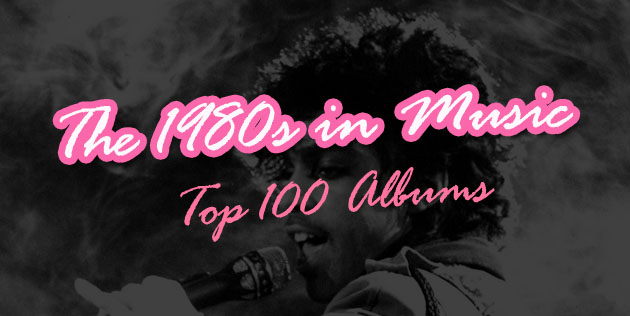
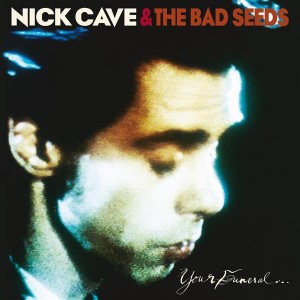
100.
Nick Cave and the Bad Seeds
Your Funeral… My Trial
[Mute; 1986]
The volatile bleakness of Nick Cave’s early stint in the Birthday Party be damned, Your Funeral… My Trial is midnight at the morgue. The CD bonus track “Scum” is a vicious attack on a critic and former friend, Mat Snow, that had the nerve to give him a bad review. Or, as Cave articulates, he’s a “miserable shitwringing turd.” Elsewhere, there’s the horror story of a circus catastrophe on “The Carny” and the brooding strength of “Stranger Than Kindness.” The entire album is submerged in despair, and with only one cover to speak of (Tim Rose’s “Long Time Man”), this is the Bad Seeds’ turning point: a significant shift to original, powerful material. Tender Prey would continue this trend, and is likely just as deserving to be on this list. If you’re new to Nick Cave, Your Funeral would be a great introductory point; this and every subsequent album has largely squelched Snow and his ilk.
– Michael Tkach
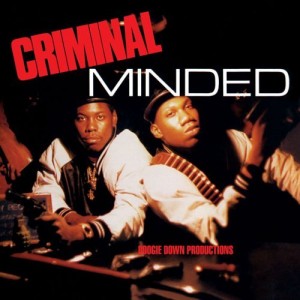
99.
Boogie Down Productions
Criminal Minded
[B-Boy; 1987]
How quickly we forget. Younger heads are fond of the word “dusty” – they use it for albums such as Illmatic, and if that’s dusty, then Criminal Minded must be freakin’ archaic. I’m not fond of the idea, but it’s nearly true: KRS himself surpassed the album with his next two records, and so on. Yet, just about anything you enjoy about hip-hop, thank this album. The foundations of East Coast gangsta, the weapons rakishly displayed on the cover, heavy sampling (as well as the plethora of musical influences to be found), hell, even the first-person crime story was essentially popularized here. As with anything in music history, it’s a tricky business: the late ‘80s saw rise to the great rap revolution, so several individuals can lay claim to the same advancements, however, undisputedly, The Blastmaster and crew ensured their place in history here. It’s easy to call an album like this outdated, but nothing could be further from the truth. Listen to any recent gangsta album worth its salt; they’re still pretty much borrowing leaves from KRS’ rhyme book. Hell, it’d do KRS himself some good to give it another listen; he may recall his own fire and stop his disappointing role as hip-hop’s preacher. An album so influential it was inevitably relegated to memory. Making this mandatory listening would sure clear out the Waka Flacka’s of the world fast, they’d be instantly irrelevant.
– Chase McMullen
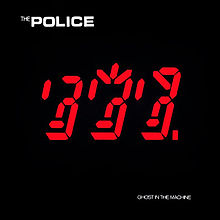
98.
The Police
Ghost In The Machine
[A&M; 1981]
For their fourth studio album, The Police stepped away from the reggae-punk aesthetic of their first three records and moved in a more overtly pop direction, adding horns and synths to their mix. Sting was already as consistent of a pop songsmith as there was in the new-wave movement, and Ghost in the Machine features some of his best work. The hits “Spirits in the Material World,” “Every Little Thing She Does is Magic,” and “Invisible Sun” are great, but the best tracks here are the ones where Sting, Andy Summers, and Stewart Copeland stretch out. The trio’s new, diversified sound would be further refined on their 1983 swan song, Synchronicity, but this transitional work is arguably even more fascinating and worthwhile.
– Sean Highkin

97.
They Might Be Giants
They Might Be Giants
[Restless / Bar/None; 1986]
Two guys named John (Flansburgh and Linnell) stand out as quirky misfits in a decade full of quirky misfits and their self-titled 1986 debut could stand alone as a fair representation of the group that has persisted for more than 25 years. Are there overly-clever throwaways? Look no further than track number three, titled “Number Three.” Are there irreverent exercises in art pop that would leave most audiences shrugging their shoulders? Try “Youth Culture Killed My Dog” or “Toddler Hiway.” But, what They Might Be Giants might be best remembered for, and which would clearly continue on future releases Lincoln and Flood, is that beyond all the clever wordplay and cheap-o drum machine beats are unforgettable, strangely affecting hooks on which their best songs hinge: “Don’t Let’s Start,” “She’s An Angel,” and “Everything Right Is Wrong Again.” They Might Be Giants quickly put any fears to rest that they were nothing more than a novelty act known for recording songs on answering machines, and with a little help from MTV, they were well on their way to becoming one of the more unexpected success stories of the ‘80s.
– Philip Cosores
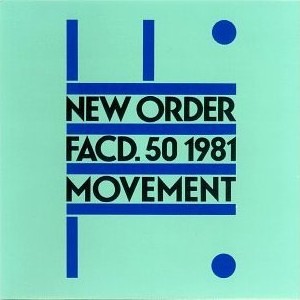
96.
New Order
Movement
[Factory; 1981]
New Order’s debut album is one that very much falls between two stools; it tries to continue down a similar direction as Joy Division while simultaneously trying to find a new sound as a new band. Ian Curtis’ shadow looms large over many of the tracks on the album, which sound like they’re almost directly cut ripped off from Closer; the plodding bass and drawn out vocals of “Truth,” the drums of “ICB” are strikingly similar to “Atrocity Exhibition” and the slow doom-like build of “Doubts Even Here,” which seems tailor-made for Curtis’ vocals – though Bernard Sumner gives it a good shot.
Simultaneously there are elements of the avant-dance-rock group that they would go on to be in the bouncy bass and synth of “Chosen Time,” the clamorous drums and guitars of “Denial” and the spacey highlight “The Him.” Every song on this album is an exciting and interesting experience, and while it could be criticised for being stuck between two sounds, half a cup of Closer and a dollop of Power, Corruption and Lies still makes a pretty tasty meal.
– Rob Hakimian

95.
Bad Brains
Bad Brains
[ROIR; 1982]
The big yellow lightning bolt on the front of Bad Brains’ self-titled debut was an apt design choice. Not only did it perfectly capture the anarchical “fuck you” message to the Feds in the band’s home base of Washington D.C., it also accurately signaled the lightning-fast pace of the album’s 15 tracks. Bad Brains was one of the first albums to demonstrate, in sonic form, how punk and metal were so intrinsically similar — and continually influencing one another in the early 1980s. Bad Brains used skillful metal guitar work, dub reggae, and the in-your-face energy of hardcore punk to get their message across. Most people didn’t expect them to be a crew of African-American guys, and they were subversive in that way, too. The true spirit of punk — the idea of defying people’s expectations — flourishes in this album, and to this day, I don’t know a single punk who doesn’t consider it a huge influence. Songs that you might consider using as entry points, if you’re unacquainted: “Big Take Over,” “I,” “Attitude,” and the frequently-covered “Right Brigade.”
– Arika Dean
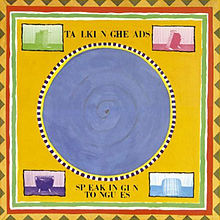
94.
Talking Heads
Speaking In Tongues
[Sire; 1983]
From the funk-inflected bassline and moonlit synth dollops of opening track “Burning Down the House,” 1983’s Speaking In Tongues presents itself as a decidedly more eclectic affair than the existentially troubled Remain In Light. On “Making Flippy Floppy,” David Byrne’s typically cryptic lyics are backed by an unexpectedly straightforward and dance-ready musical arrangement that includes (of all things) a cowbell. A cowbell! “Our president’s crazy, did you hear what he said?” Byrne asks, though it doesn’t really matter which particular Reagan soundbyte he’s referring to. “There are no big secrets; don’t believe what you read,” Byrne contradictorily adds. Such is the case with the album as a whole; the Heads didn’t simply retread into familiar art-rock territory following Brian Eno’s departure, though the album is certainly a more accessible affair than most of the Heads’ prior material. No surprise that “Burning Down the House” became the band’s first and only Billboard Top 10 single. On Speaking In Tongues, Byrne and company proved that they could open up their sound without sacrificing their soul. Case in point: that weird gurgling noise on “Girlfriend is Better” (and parts of “Slippery People”) could have been abrasive and unnecessary but instead adds a surreal industrialism to the band’s sound. It’s very weird, but in a way that you’d want to hear again and again.
– Josh Becker
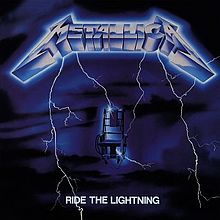
93.
Metallica
Ride The Lightning
[Megaforce / Music for Nations / Elektra / Vertigo; 1984]
Hey, Metallica, you’ve just put out a highly successful, debut thrash-metal record, what are you gonna do next? “We’re gonna play some acoustic guitar!” OK, that’s probably not what the band was thinking when they wrote “Fight Fire With Fire” and made it the first cut on their sophomore release, Ride The Lightning, but talk about setting the tone. Yes, those heavy riffs and apocalyptic lyrics were still there, but Ride The Lighning saw Metallica taking on more complex harmonies and melodies, and willingly pushing themselves in new directions. The thundering “For Whom The Bell Tolls” is a headbanger’s dream, and Kirk Hammet’s solo on “Fade To Black,” the anti-suicide power ballad, is one of the most shred-tastic moments in Metallica’s discography (as is the one in “Creeping Death”). Following up Kill ‘Em All was no easy task, but the intricacies of Ride The Lightning built from the record’s assuredly metal base, proved that Metallica were more than just your run of the mill thrash band.
– Jon Blistein
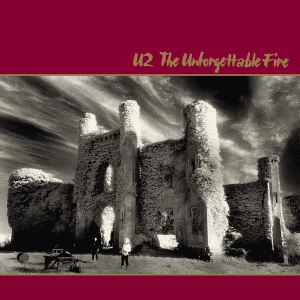
92.
U2
The Unforgettable Fire
[Island; 1984]
Whatever people think of as the “U2 sound” was born here. The Unforgettable Fire marks two crucial transitions for the group: the transformation of Bono’s lyrical sensibilities from largely political to largely personal, and The Edge’s, Adam Clayton’s, and Larry Mullen’s shift in sonic focus from punk energy to the kind of atmospheric chiming that would inform the entire careers of more bands than you could name (you know who they are). This second development is due no doubt to the band’s working for the first time with Brian Eno and Daniel Lanois, whose production colored the album’s highlights from the epic centerpiece “Bad” to the MLK-celebrating anthem “Pride (In the Name of Love),” which became one of U2’s more enduring hits.
– Sean Highkin

91.
Prince
1999
[Warner Bros.; 1982]
By 1982 Prince had already established himself as a wunderkind, developed a sexually abrasive and “weird” stage persona, and recorded four albums including masterpiece Dirty Mind. In Prince’s world, this meant it was time for a career-breaking double album, which is exactly what the world received with 1999. The album bursts at the seams with funky dance gems such as the apocalyptic title track and the schizophrenic synth-pop of “Delirious.” Great as those tracks are (they rank with the best of the best of Prince’s entire songbook), the real revelations come on “Little Red Corvette.” The song, Prince’s biggest hit to date, captured a different side of The Purple One. It’s an early example in a long line of Prince double entendres, and provides a preview of the more sexually cautious Prince that would later emerge on Sign O’ The Times. Musically, the track is perfect pop. Synthesizers simulate the slick movement of the song’s namesake vehicle, building to one of the best choruses of the ‘80s. The rest of the album was similarly impressive, setting Prince up for a decade of chart dominance.
– Jason Hischhorn
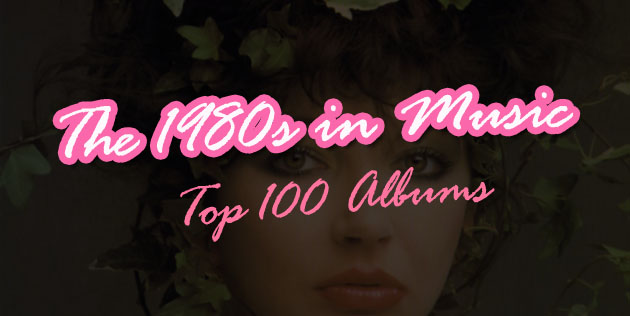

90.
Iron Maiden
Piece of Mind
[EMI; 1983]
Following the massive success of The Number of the Beast, Iron Maiden had to prove that they had staying power. Piece of Mind not only accomplished that, but it was really a stepping stone to a run of excellent albums. It’s true that later in their career they got more adventurous (Powerslave, Seventh Son of A Seventh Son), but there is something so alluring about the simplicity of this album. Not to say musically it was simple, but that it’s just a great metal album that sticks to the basics. This album really has everything you could want in a Maiden album; the iconic and insanely catchy riffs from the “Trooper,” the melodic “Revelations” that switches from its pounding riffs to its phenomenal guitar licks, or “Flight of Icarus” with its bombastic chorus. A lot of this was a pre-cursor to their later songs that would be even more epic and over the top. Ultimately Piece of Mind showed that Maiden wasn’t a one trick pony. And while it might not be their most expansive work in terms of musical scope, it could easily be argued to be their finest album.
– Brent Koepp

89.
XTC
English Settlement
[Virgin; 1982]
Transitioning from a post-punk powerhouse to a braver form of jittery psychedelic pop, the double-album English Settlement marks XTC’s breakout moment behind the power of its first single “Senses Working Overtime.” Unfortunately, this fame would lead Andy Partridge to a mental breakdown while touring the album. Diving into their work is daunting considering the sheer volume of their output in the ‘80s alone. The two albums represented on this list, English Settlement and Skylarking, are certainly worthy of celebration, and mere shades better than Black Sea, which was very much an extension of the sound they mastered on Drums and Wires. Their Dukes of Stratosphear pseudonym allowed Partridge and Colin Moulding to pay a more direct homage to ‘60s psychedelia, but it was on this album that they apparently were taking notes from Talking Heads, and recorded one of their most ambitious and coincidentally well-accomplished works.
– Michael Tkach

88.
The Smiths
Strangeways, Here We Come
[Rough Trade; 1987]
Tensions between Morrissey and Johnny Marr were tearing the Smiths apart by the time they began recording their fourth LP, but it didn’t stop them from coming up with some of their best material yet. Strangeways is best known for the hits “Girlfriend in a Coma” and “Last Night I Dreamt That Somebody Loved Me,” but the real stunner is the “Paint a Vulgar Picture.” The song is a screed against record companies that doubles as perhaps the best-ever showcase of Marr as a guitarist. Marr can also add to his sterling session-guitarist audition tape “I Started Something I Couldn’t Finish,” “Stop Me if You Think You’ve Heard This One Before,” and “Death of a Disco Dancer.” The songs on Strangeways are glossier and shinier than anything else in the Smiths’ oeuvre, bringing in horns and synth strings. Strangeways is the sound of one of the great bands of their era not only at their peak musically but also at something of a crossroads, making it a fascinating historical document as well as an enduringly rewarding collection of songs.
– Sean Highkin
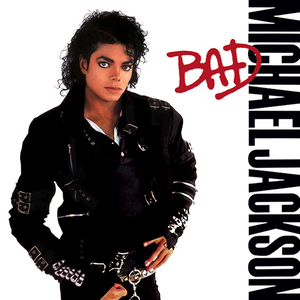
87.
Michael Jackson
Bad
[Epic; 1987]
Following-up a successful album is a daunting task, but one that is both universally acclaimed and the biggest seller of all-time? Although another monstrous hit, the paranoia-exuding Bad has not enjoyed quite the same level of commercial and critical success as Thriller, but in all fairness, what can? On Bad, Michael Jackson pushed the art of a slick studio production further than ever before. While this gives a layer of artifice to the emotionality of some songs and proves that not even “studio magic” can breathe life into disappointments like “Liberian Girl,” the likes of “Smooth Criminal,” “Man in the Mirror” and the title track are more than strong enough to stand alongside the best of Thriller and Off the Wall.
– Frank Mojica
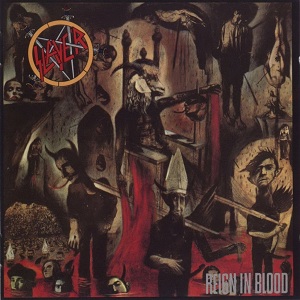
86.
Slayer
Reign In Blood
[Def Jam; 1986]
At just under 29 minutes in length, Reign In BloodReign In Blood has this mystique to it. Maybe it’s Araya’s disturbing lyrics, or just how abrasively the album hits you, it’s often seen as one of the heaviest metal albums of all time, and rightfully so. But what really makes this album great is how the band can transition on a dime from going 100mph to slowing down and launching into an epic break down of colossal riff and bass lines that will blow your ear drums.
– Brent Koepp
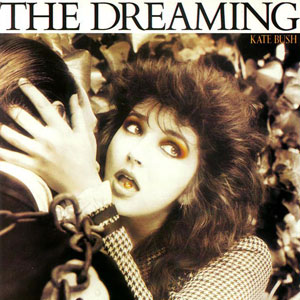
85.
Kate Bush
The Dreaming
[EMI; 1982]
The British cult hero had begun to move away from the singer-songwriter mold on her third album, 1980’s Never For Ever, but nothing could have prepared fans for the transformation she underwent on The Dreaming. Bush’s voice is at times unrecognizable here, being that she had begun around this time to experiment with all manner of synthesizers and other methods of digital manipulation. Her work had always been decidedly outside the box, at least in the realm of British pop singers of the time, but her reputation as the pre-eminent art-rock siren of the last three decades, and the starting point for careers from Tori Amos to Bjork, starts here, with “Sat in Your Lap,” “Get Out of My House,” “Night of the Swallow,” “There Goes a Tenner,” and others.
– Sean Highkin
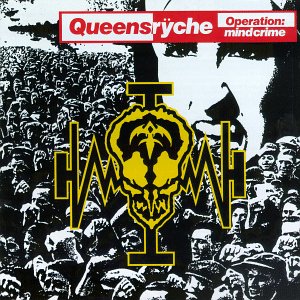
84.
Queensryche
Operation: Mindcrime
[EMI; 1988]
Not only is Operation: Mindcrime one of the most criminally underrated albums in the ’80s, Queensryche are also one of the most overlooked bands in the metal genre. Which is a damn shame, because not only is Geoff Tate one of the best singers in the genre, Operation: Mindcrime is one of the best concept albums of all time. The story revolves around an insane man who is in a mental institution and is trying to remember how he got to this point. What then unfolds across the album is a recollection of his memories. In a time of public outcry due to a corrupt government, our main protagonist Nikki is tricked into joining an organization dedicated to revolution. This organization is led by a mysterious figure named “Dr. X” who then brainwashes Nikki into being his assassin. Just by uttering the words “Mindcrime,” Nikki is sent into a fit of rage, and kills his political targets.
Then throw in a blasphemous story of him falling in love with an ex-hooker-turned-Nun, and you have one insane story. Drugs, sex, brainwashing and political assassinations – sure on paper that sounds cartoony, convoluted and, well, stupid, but what makes this concept so amazing is the performance by Tate. He transforms himself into Nikki, and you really feel the character’s pain, sorrow and anger through his incredible voice. It’s this performance that really sells the story, and keeps you on the edge of your seat as you want to figure out what the hell happened to this character to bring him to a mental institution. But the really great thing about Operation: Mindcrime is that musically, it’s just damn good. Even if you couldn’t care less about the story, it’s a powerhouse of powerful anthems, and incredible instrumental work.
– Brent Koepp
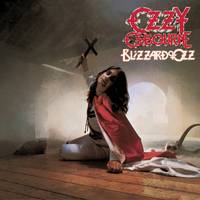
83.
Ozzy Osbourne
Blizzard of Ozz
[Jet; 1980]
Blizzard Of Ozz was released in September 1980 in the UK and was Ozzy Osbourne’s debut solo album after being fired from Black Sabbath in 1979, and it is without a doubt his best solo album. With Sabbath in 1970s Ozzy Osbourne helped to create and define the heavy metal genre, but by the end of his time with Sabbath much of the former greatness had been lost to substance abuse, however Blizzard Of Ozz showed Osbourne to be revitalized – as Sabbath’s first album with new singer Ronnie James Dio did.
Blizzard Of Ozz is, despite Osbourne’s contribution, very much a showcase of the talent of Ozzy’s new guitarist Randy Rhoads, who would die in a plane crash in 1982 – making this and the follow-up Diary Of A Madman his defining documents. Rhoads was one of the premier heavy metal guitarists, with the invaluable ability to turn his impressive skills to benefit the song and not just his ego. Rhoads shines throughout the record and his playing coupled with several of Osbourne’s best tracks in “Crazy Train,” “Mr. Crowley” and “Suicide Solution” makes Blizzard Of Ozz into one of the most important metal records of the 1980s.
– Johan Alm

82.
Morrissey
Viva Hate
[Sire; 1988]
Viva Hate was released only six months after The Smiths released their final album, and, as the title suggests, Morrissey was not shy about his discontent with his musical affairs. Musically, Viva Hate begins where The Smiths left off and contains a couple of the singer’s finest singles, with or without The Smiths, in “Suedehead” and “Everyday Is Like Sunday.” Today, the latter has been co-opted by Fox to advertise the NFL on Sunday, but at the time, it was these songs on Viva Hate that kept Morrissey’s forward momentum in full force, allowing him to still be among musical royalty; an artist whose every bit of musical output is still anticipated and shown the utmost respect. Except for the football thing. That was just weird.
– Philip Cosores

81.
The Clash
Sandanista!
[CBS / Epic; 1980]
The Clash’s triple-vinyl follow-up to London Calling might be the most highly-regarded album of its era that the least amount of people have actually listened to in its entirety. Its 36 tracks amount to a hodgepodge of classic punk, reggae, early hip-hop and dub experiments, soul, and — quite literally — everything else you could name. About half of it is filler, but it’s the kind of filler that’s fun to listen to once, and even when you strip that away, it still leaves at least an album’s worth of classics. “Police on My Back,” “Washington Bullets,” “The Magnificent Seven,” “Up in Heaven (Not Only Here),” and “Somebody Got Murdered” all rank right there with the best Clash material ever recorded. The fact that the biggest punk band in the world was willing to go this far outside their lane and risk falling on their face was at once a middle finger to punk purists and one of the most punk-rock things a band could do.
– Sean Highkin
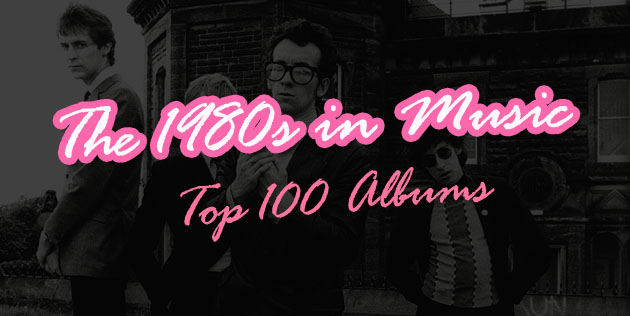

80.
Cocteau Twins
Blue Bell Knoll
[4AD; 1988]
In 1986, the Cocteau Twins released two albums unlike anything else they’d recorded before: the sparse, guitar-driven Victorialand and a collaboration with avant-garde pianist Harold Budd entitled The Moon and Melodies. In the wake of these experimental, genre-expanding releases, 1988’s Blue Bell Knoll might have seemed like a retread into safe, more conventionally structured material. Indeed, critical consensus dismissed the record for just this reason. But whereas many at the time of its release considered it solid yet unremarkable, Blue Bell Knoll has rightly gained increase prominence in recent years. Rather than backtracking to previously explored territory, the album is the sound of a band doing what they do best: spacey pop-rock with a gorgeous, glassy bent, from the synthy harpsichord elegance of the opening title track to the haunting charm of songs like “For Phoebe Still a Baby.” In light of their follow-up, 1990’s Heaven or Las Vegas, Blue Bell Knoll can be seen as an important bridge in their discography between the band’s earlier, more ethereal work and their later pop-oriented records. But it should also be seen as a terrific little pop album that hits all the right notes. Blue Bell Knoll may not be the Twins’ most challenging work, but it is certainly among their most satisfying.
– Josh Becker

79.
Galaxie 500
Today
[Aurora; 1988]
True, On Fire is the Boston band’s magnum opus, but Today laid the groundwork for that record’s relaxed poignancy; the latter provides the blueprints for the former’s listless architecture. But it’s also beautiful considered in its own right, a quality made all the more remarkable by the fact that Galaxie 500 was but a guitar-bass-drums band at the time. That they manage to make such achingly rich music with such common instruments is a testament to the band’s two biggest nascent strengths: a keen ear for pop hooks (opener “Flowers” is especially indelible) and a knack for the hazy garage-jangle Americana of early R.E.M. (“Parking Lot” and “Oblivious” immediately come to mind, though the whole album could easily fit this description). Indeed, Today is an amalgamation of garage rock, guitar pop, and ambient styles, and this is seen most evidently on “Instrumental,” a brief track that makes up for its lack of vocals with a killer guitar riff that calls to mind the seemingly happy yet ultimately melancholic guitar work on Bowie’s “Sound and Vision.” This is Today’s true thesis: that even ennui can sound beautiful. Plenty of bands have since sought to recreate Galaxie 500’s sound, but few could ever match it.
– Josh Becker
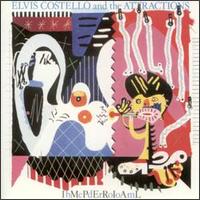
78.
Elvis Costello and the Attractions
Imperial Bedroom”
[Columbia; 1982]
One of the most vivid memories I have of my freshman year of college is walking down Central Park West through the pouring rain, tripping on four hits of acid, and watching skyscrapers disintegrate into sand. “Beyond Belief” blared through my headphones. Christ, what a way to start a record. Elvis sings like he’s in a trance, backed up by swirls of guitar chords, a pounding bass drum, and an organ caked in so much reverb it sounds like it’s being played in another dimension and we’re just hearing whatever traces of sound made it into our universe.
Oh, and the rest of the album is pretty damn good, too.
The production is a far cry from the stripped down sound of This Year’s Model and Trust. It’s an 80s album, but if I didn’t know better, I’d guess it was released in 1967. The Sgt. Pepper-esque accompaniment is almost enough to distract from how dark the lyrics are. In “You Little Fool,” Costello stammers out “I suppose that you’re going to stay all night” with such scorn that you can’t help but wonder what the girl did to the poor bastard. The way he sings “To murder my love is a crime,” in “Man Out of Time,” you know he’s spent a lot of time thinking about it.
Still, what makes this album so special is the way Elvis ties these contrasting elements together. A combination of impeccable production and the sincerity Costello brings to his mostly-caustic songwriting makes Imperial Bedroom a complex record that dabbles both in sunshine pop that would make Brian Wilson jealous and scathing assaults that make “Positively Fourth Street” sound like “Love Me Do.”
– Jeremy Bunting
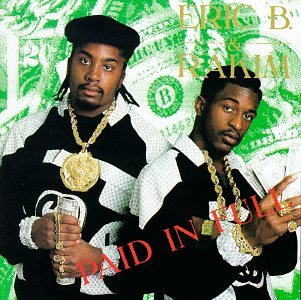
77.
Eric B. and Rakim
Paid In Full
[4th & B’way / Island; 1987]
Possibly the most relaxing hip-hop album of all time (yes, that’s high praise), Eric B & Rakim’s classic Paid in Full is the epitome of confidence and soulfulness, with early scratches and cuts from DJ pioneer Eric B. as the canvas. Rakim’s smooth and methodic flow was stark in contrast to MCs like KRS-One or Chuck D who treated the mic like a loudspeaker, the internal rhyme and lyricism on the record became the standard for his contemporaries. The album’s first single, “Eric. B is President,” features one of the most recognizable hooks in rap’s history, “make ‘em clap to this,” and future singles such as “I Know You Got Soul” and “I Ain’t No Joke” have since become legendary. And the same goes for the popularity of Paid in Full. It took until 1995 for the album to finally go Platinum, and while the original sales and reviews were temperate, Paid in Full is now universally regarded as one of the most influential and popular hip-hop albums of all time.
– Erik Burg
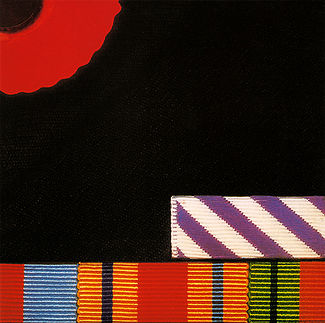
76.
Pink Floyd
The Final Cut
[Harvest; 1983]
As far back as 1977’s Animals, Floyd guitarist David Gilmour seemed to be becoming marginalized in the songwriting process. This continued with The Wall, Waters’ highly personal rock opera about the paranoia that comes with rock stardom, and was pushed past its breaking point on this misunderstood 1983 album. The Final Cut was even more personal than The Wall, dealing with the death of his father in World War II. Despite featuring the group’s classic lineup (for the final time), The Final Cut is a Pink Floyd album in name only, but the songs, including “Two Suns in a Sunset” and “When the Tigers Broke Free,” are hauntingly beautiful, foreshadowing the quietly brilliant solo career Waters would go on to have throughout the ‘80s and ‘90s.
– Sean Highkin
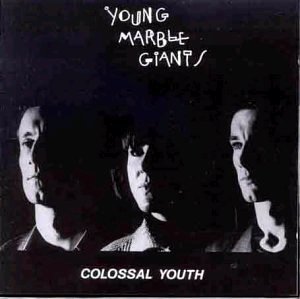
75.
Young Marble Giants
Colossal Youth
[Rough Trade; 1980]
It’s strange to me that both the band and album names, Young Marble Giants and Colossal Youth, suggest a grandness in scale, but the music held within is actually some of the most purposefully slight ever created. Colossal Youth is often lumped in with the post-punk movement that was at full tilt at the time of its release, and although there are certainly elements of post-punk – notably in Stuart Moxham’s choppy rhythm guitar playing – Young Marble Giants’ music stands firmly apart from any music then or since. Young Marble Giants not only lacked a drummer, they lacked a drum machine, utilising cassette recording instead. The album was recorded in half a week and overdubs were minimal. This leaves the album sounding so organic and intimate that shutting your eyes while listening will make you feel as if you are in the company of the band as they play. The lyrics flit seamlessly from the natural to the abstract, all delivered in Alison Statton’s voice which is as soft and sweet as jelly and ice cream.
In the in the three decades since the album’s release nobody has ever made an album like Colossal Youth. It’s probably because, despite all the hi-tech or lo-fi recording techniques that are prominent today, nobody will ever be able to recreate the perfect combination of subtle elements that this band had for those three days holed up in a North Wales recording studio.
– Rob Hakimian
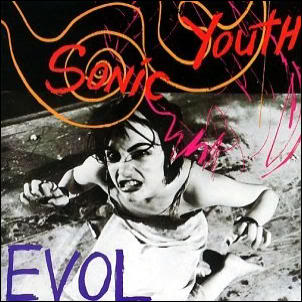
74.
Sonic Youth
EVOL
[SST; 1986]
EVOL has become known as Sonic Youth’s transitional record. It was the group’s first with SST and their first with drummer Steve Shelley, but more importantly it was the group’s move into more melodic and approachable song craft. Sister and Daydream Nation would follow, continuing the trends set on EVOL (and perhaps focusing them), but EVOL still stands firmly on its own. It combines the darkened, detuned atmospheres of previous outings (namely Bad Moon Rising) with pop-leaning structure and the vocal dynamic the group would settle into for the rest of their career. As ambitious as Bad Moon Rising was, and despite moments of genius on Confusion Is Sex, EVOL is the first album from Sonic Youth worthy of the title.
– Will Ryan

73.
Run-D.M.C.
Run-D.M.C.
[Profile / Arista; 1984]
Run-D.M.C.’s 1984 self-titled debut LP is easily one of the most influential hip-hop albums of all time. The album opener “Hard Times” introduced the world to the hard hitting, stripped down beats consisting of only drum machines and well-timed cuts & scratches courtesy of Jam Master Jay.
The second track on the album, “Rock Box” was a huge runaway success. The trio utilized heavy guitar reverb and their trademark slapping drums to cement their place as the Elvis of hip-hop. In the decades to follow, artists as diverse as Jay-Z, Slick Rick and De La Soul would sample this track.
Building on Grandmaster Flash & The Furious Five’s model of back-and-forth rhyming, Run-D.M.C. took it a step further by being the first to point out “sucker MCs” and the evils they do. Without Run-D.M.C.’s freshman LP hip-hop as we know it today would be completely different
– Marc Heilbrunn
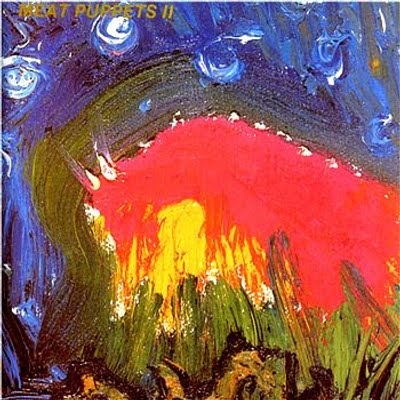
72.
Meat Puppets
Meat Puppets II
[SST; 1984]
It’s not unusual that my path into this album was paved by Nirvana, I’m certain that’s the case for way more than a few of us. While the influence on Nirvana is tangible on the few songs that they exposed to the rest of the world, it becomes easy to overlook the rest of the album which seems to have had as important an effect on an entirely different corner of music. The whole punk/country blend seemed to predict a lot of what was coming with alt country in the ‘90s, and while that influence may not be as desirable as the adoration of a Kurt Cobain, they had at least a small hand in shaping a whole sub-genre of music which is more than most bands can say.
– Colin Joyce

71.
The Cure
Pornography
[Fiction / A&M; 1982]
Pornography must have certainly been a shock for every kid who heard “Lovecats” in 1983 and purchased the band’s latest effort in hope of more danceable, radio-friendly pop. The record may be the bleakest, most depressing statement in the band’s lengthy catalogue; gory lyrical imagery and harsh sound experiments included. Yet, in the gloomy atmosphere and sheer sonic power hides something strangely cathartic and comforting. Not for Smith though – the time following Pornography would be dominated by radio pop and too many drugs.
– John Wohlmacher
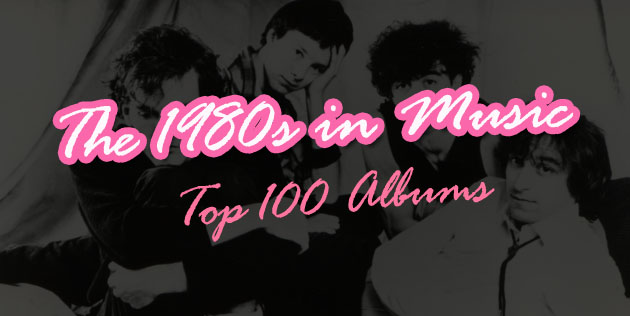

70.
Black Sabbath
Heaven and Hell
[Vertigo / Warner Bros.; 1980]
I don’t think anyone will dispute the fact that Black Sabbath are considered by many to be the forefathers of metal. Their heavy sound and dark themes really paved the way for the genre. But many will defend to the death that the best era of Sabbath was led by Ozzy Osbourne. And this is true. Sabbath’s golden era was with Ozzy. And while it’s easy enough to write off a band that continues on without their original singer, you can’t when it’s Ronnie James Dio. Dio personifies the genre more than any other singer. The dramatic vocals, the sinister bite as he growls out lines. If Black Sabbath were the forefathers of metal, Dio was the grandfather of Metal. He’s a legend, to say the least.
And It’s because of Dio that this album really stands on its own within the Sabbath catalogue. Dio’s unmistakable vocals and theatrical presence, combined with a band that had eight albums already under their belt makes for one of Sabbath’s most energetic albums in their canon. Heaven and Hell, in a lot of ways, is an overview of Sabbath’s early career musically, running the gamut of their various stylings. But with a renewed energy, it’s really one of the band’s finest outings. The album is so revered that Sabbath reunited twenty years later with Dio and toured and recorded under the name “Heaven and Hell.” With Dio passing in 2010, this album will no doubt be one of his biggest achievements in his long career.
– Brent Koepp

69.
R.E.M.
Document
[I.R.S.; 1987]
Document has always struck me as an unbelievably accessible album, not just for R.E.M., but for any band — it epitomizes that ‘80s college rock/mainstream crossover sound, because, well, that’s exactly what it was. The riffs were bigger and the production cleaner, but the political and intellectual savvy of Stipe and Co. remained completely intact. There’s the band’s excellent cover of Wire’s “Strange,” the deft McCarthy Hearing-sample in “Exhuming McCarthy,” and Peter Buck’s siren-like guitar on “Finest Worksong,” a certain call-to-arms. But it’s the album’s hits, “It’s The End Of The World As We Know It (And I Feel Fine)” and “The One I Love” that propel Document to legendary status — the former a stream-of-consciousness cultural overload that breaks into that gleefully desolate, and comprehensible, chorus (plus: Leonard Bernstein!); the latter a simple, sardonic anti-love love song that’s become a late-night lovers radio request mainstay. And if you got the jokes, great; if not, so what? The tunes were just that good.
– Jon Blistein
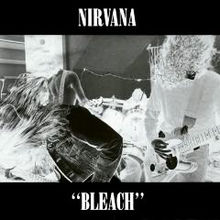
68.
Nirvana
Bleach
[Sub Pop; 1988]
When Bleach was released in June 1989, it would have been almost impossible to predict that Nirvana would become the most notable band of the following decade. Even looking back at it now, it’s difficult to gauge its exact impact; the enormous dust cloud kicked up by Nevermind is thick and unmovable, and for better or worse, Bleach‘s lasting impact has been – at least to some degree – pulled under its shadow. But if you really squint your eyes and focus your ears, it isn’t difficult to see why Nirvana’s first album charted on our list. Here, Kurt Cobain and company hadn’t yet been thrust into the spotlight. This album has them playing with a more indie-leaning sound and grittier production. “Floyd the Barber,” “About a Girl,” and “Negative Creep” remain among the best songs in the band’s short-but-famed canon, a compliment that could similarly be paid to the album they appear on.
– Andrew Bailey

67.
The Feelies
Crazy Rhythms
[Stiff; 1980]
Those beats are just so fresh! Thirty years on, and The Feelies’ absolutely blistering debut Crazy Rhythms is still something to behold. Hell, just from a stylistic stand point, you have to respect the part about how it basically helped usher in that whole “straight-laced geek” look into the indie landscape, as it were. But (obviously) more important than that, Crazy Rhythms was a God-damned percussion factory, churning out meticulously-timed compositions of almost symphonic origin. Because, while The Feelies expertly matched their jangly riffs with those crisply cracked vocals, Crazy Rhythms was also backed by, perhaps, the strongest rhythm section of its time. Bold, and completely innovative in its forward thinking and structural choices, the tracks on Crazy Rhythms feel more like raw, jagged components than they do a cohesive whole – which is actually a compliment. Crazy Rhythms remains a perfect modern showcase of sonic architecture, and basically the…most example of a post-punk album, maybe ever.
– Daniel Rivera
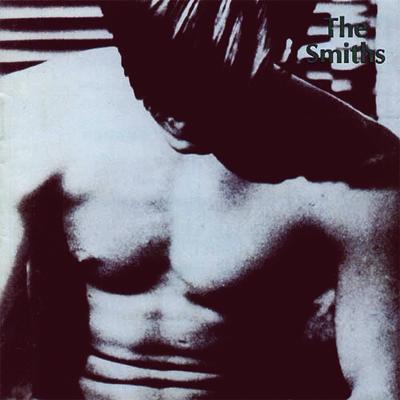
66.
The Smiths
The Smiths
[Rough Trade; 1984]
In light of the way Morrissey would progress as a songwriter over the following Smiths albums and later into his solo career, it’s interesting, and sort of sweet, to hear the man sounding genuinely earnest on The Smiths’ introduction. Opening song “Reel Around The Fountain” has the honesty to proclaim that “15 minutes with you” is something he greatly desires, but of course, knowing the man as we do now, this couldn’t last. Songs like “Pretty Girls Make Graves,” “The Hand That Rocks The Cradle” and “Suffer Little Children” showed the darkness that would encroach everything Morrissey produced for the rest of his career. Yet it was still a massive hit.
This is, of course, thanks to the Morrissey/Marr partnership that formed the crux of the band. Morrissey’s honey-like crooning could make any of his soliloquies into something seductive (although here he does dabble a little with an underdeveloped falsetto) and the gorgeously jangly guitar work of Johnny Marr single-handedly made songs into something catchy. When Morrissey actually decided to write a chorus and paired it with Marr’s tuneful prowess it was guaranteed to be a hit. Although most of these instances were saved for non-album singles that followed The Smiths, songs like “Hand In Glove” and “This Charming Man” (not actually featured on the original release, but on every subsequent one) were enough to attract people in to the album, and give them the perfect introduction to a band that would go on to be one of the mainstays for UK indie fans for decades to come.
– Rob Hakimian

65.
X
Los Angeles
[Slash; 1980]
X, as a band, have always carried with them that curious and rare espousal of style and substance. Founded by John Doe and co. in 1977, X released their debut album Los Angeles three years later, perfectly showcasing the punk outfit’s socially bratty attitudes, off-center allure, and surprisingly honed knack for pop-like brevity. Philosophically, this was to be the definition of “punk” (with its own distinct rockabilly flourishes), but in practice it was a wisely packaged exercise in expectation and subversion. Laced with tons of the kind of hookish magic that an album by such a band would seemingly shy away from, Los Angeles was decidedly dark, but not entirely without a soul. Filled to the brim with surprisingly unique harmonies, and charming (though esoteric) poetic rantings, Los Angeles was a full throttle sonic experience that found its many, tenuously held together facets shown in vibrant and satisfying display.
– Daniel Rivera

64.
Depeche Mode
Music for the Masses
[Mute / Sire; 1987]
With that famously honed atmosphere of dark tension, Depeche Mode’s ironically titled 1987 album Music for the Masses seemingly had very little actual interest in appealing to the world at large. Serving as an homage of sorts to the likes of Kraftwerk (while methodically co-opting that new wave method), the LP found Depeche Mode further developing their already inspired sound. Both largely theatrical and deeply thematic, Music for the Masses still seems isolated in its moral ambiguities and cryptic qualities. What brings it around to such greatness, though, is that signature way that Depeche Mode can become so wrapped up in relative melancholy, but convey so much power through reveling in those base desires; all while whistling a (not-so-happy) tune. There’s an incongruity apparent that Music for the Masses taps into quite brilliantly. Depeche Mode wouldn’t release their masterwork until three years later, but Music For the Masses was a watershed moment for a group that was on the verge of becoming legendary.
– Daniel Rivera
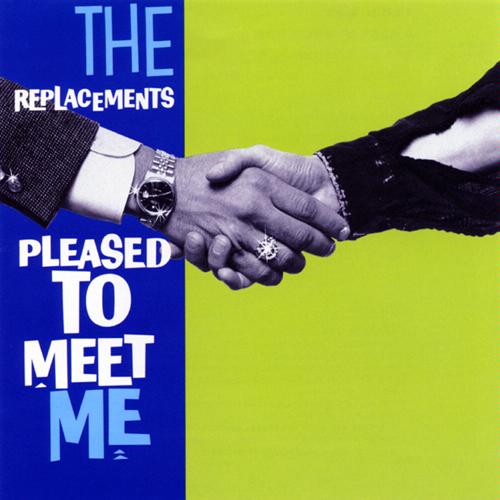
63.
The Replacements
Pleased to Meet Me
[Sire; 1987]
The Replacements made two of the greatest records of the ‘80s with Tim and Let It Be, at least in my book, and while those surely deserve the recognition it would be a travesty to ignore the rest of Westerberg and co.’s discography. Strongest among “the rest” is Pleased To Meet Me, the 1987 follow-up to Tim which saw the band moving further away from their punk beginnings, and in many ways the album heralded the end of the band – but it still contained a few of their greatest songs.
As with Tim the production leaves a lot to be desired, with a tinny sound that at times distracts from the songs, but with Paul Westerberg and the band, with new guitarist Slim Dunlop in great form it’s a fault that is easily forgiven. The stand-out track on the album is “Alex Chilton,” Westerberg’s tribute to the Big Star frontman (who also guests on the album’s other highlight “Can’t Hardly Wait”). While those two are strong enough to compete with any of their best tracks, the rest of the album marks a drop in quality – perhaps not a big one but one that keeps it from being counted among the greats.
– Johan Alm
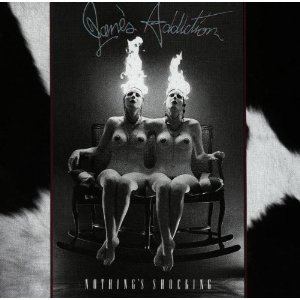
62.
Jane’s Addiction
Nothing’s Shocking
[Warner Bros.; 1988]
Nothing’s Shocking is seen as Jane’s Addiction’s most classic album, and for good reason. It’s a diverse album full of heavy swag and beautiful emotion. I can count the number of albums from the ‘80s that successfully combine the two on one hand, and this album is at the forefront.
“Up The Beach” is a great example of this. What starts off as a mellow bassline turns into wails and guitar virtuosity, and while the majority of the song is heavy, positive emotion flows in its veins. “Had A Dad,” “Mountain Song” and “Pigs In Zen” show the band at its best. Perry Ferrell’s shouts, Dave Navarro’s shredding solos, Eric Avery’s thick bass and Stephen Perkins’ pounding drums fit together in ways that modern rock groups can only dream of achieving. Softer songs like “Jane Says” and “Summertime Rolls” are perfect lighters-up-in-the-air tracks.
Nothing’s Shocking has stood the test of time and I would argue that it’s still just as relevant to music today as it was back in 1988.
– Nicholas Preciado

61.
Spacemen 3
The Perfect Prescription
[Glass, Fire, Genius Records; 1987]
Spacemen 3’s The Perfect Prescription is such a meaningful album for two key reasons. First, based solely on its own merits, it’s one of the finest pieces of drug-addled, heartbroken shoegaze to come out of the 1980s. The album’s first two songs, “Take Me to the Other Side” and “Walkin’ With Jesus,” are absolutely flawless from start to finish, representing two of the most powerful cuts in shoegaze history. There’s plenty of individual merit here, but The Perfect Prescription is also a phenomenal relic from our present perspective. Like watching footage of your childhood through the lens of modern accomplishments, The Perfect Prescription is a brilliant window into what would become of Jason Pierce’s vision (Spiritualized). For this album, both the then and the now are dripping with value.
– Andrew Bailey
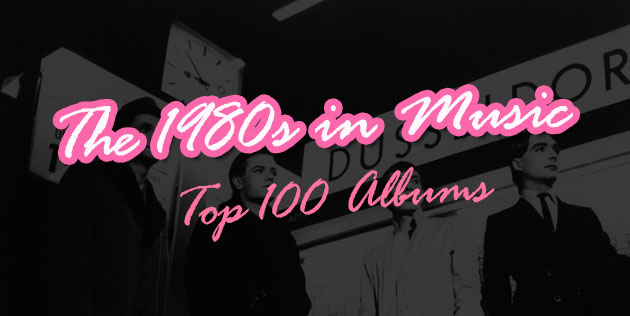

60.
Kraftwerk
Computerwelt (Computer World)
[Kling Klang / EMI / Warner Bros.; 1981]
Music and culture has long reflected developments in science. You might laugh at that statement, but it’s true: Salvador Dali’s art took a turn for the weird(er) after Einstein revolutionized science and philosophy with his Theory of Special Relativity. The development of space travel in the ‘60s was partially responsible for the genesis of progressive rock. Groups like Kraftwerk embraced the emerging computer technology of the early ‘80s and wrote it a love letter called Computer World. The album is heralded in the electronic music community as one of the most influential LPs in the genre — you can even hear a touch of Aphex Twin in the driving, rhythmically dynamic “Numbers.” But what most people don’t realize is how Computer World has been subtly influencing the mainstream for years — recognize the melody in “Computer Love”? That’s because the central motif has been adopted by Coldplay and turned into a mall radio-friendly song called “Talk.” And that’s just a modern example — Kraftwerk ushered in an entire era of computer fetishism in ‘80s pop production that was less blatantly tributary, but pervasive regardless.
– Arika Dean
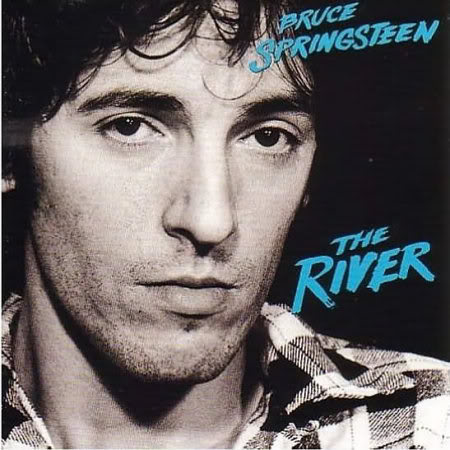
59.
Bruce Springsteen
The River
[Columbia; 1980]
The River wasn’t recorded entirely as one piece – indeed, variations, fragments and in some cases full songs had been written during the Darkness on the Edge of Town sessions a couple of years prior – but listening to it over thirty years later, you’d never really guess. The songs’ themes definitely contrast each other – from solemn to upbeat one track to the next – but it’s a testament to the strengths of Springsteen’s songwriting that it all gels into a cohesive whole, and indeed, as a concept album of sorts, it all flows along beautifully.The River, like many double albums, has its obvious stand-outs – successful singles like “Hungry Heart” – but it also has its fair share of the more obscure (or, in the case of an album this popular, relatively less acknowledged) tracks such as “Drive All Night.” Despite strong sales, the record wasn’t immediately greeted by universally positive reviews, but over time has revealed itself to be one of The Boss’s best efforts.
– John Ulmer

58.
Leonard Cohen
I’m Your Man
[Columbia; 1988]
There’s something about this album that just gets me every time. Leonard Cohen has long been known as a brilliant poetic mind and songwriter, and with I’m Your Man he’s near the top of his game. From the moment his monotone voice barrels in on “First We Take Manhattan,” the album becomes a completely spell-binding machination of ’80s pop goodness and deep-thinker’s ear food. The pop songs are full of the timeless trademarks of the decade – cheesy synthesizers, backing female vocals – but it’s the title track that, for me, ties all the threads together. If nothing else, Cohen is a lover, a practical ticking time bomb of emotion. On “I’m Your Man” he exerts that to the fullest, and when he offers “if you want another kind of love, I’ll wear a mask for you,” it sends the whole album soaring.
– Andrew Bailey

57.
Iron Maiden
The Number of the Beast
[EMI; 1982]
While I could easily argue that The Number of the Beast isn’t even Maiden’s best album, there is no denying that it’s their most iconic. Without a doubt TNOTB stands out for a lot of reasons as being one of the most recognizable and influential metal albums of this decade. Whether it’s the iconic album art (who doesn’t love Eddie?) or the well-crafted balance of fast paced riffs and anthemic choruses, TNOTB was in a league of its own.
Iron Maiden bridged the new wave of British heavy metal movement with mainstream accessibility without ever compromising the music’s integrity. They had the technical proficiency to impress even the most diehard metal heads (Harrison’s blistering bass, Dickinson’s insane pipe range, and Murray’s gift for melodic riffs) as well as having incredibly catchy and accessible choruses. And it’s for this very reason that even today, Iron Maiden are considered one of the royalties of metal. All the more impressive is the fact that this album was the introduction to many of Bruce Dickinson, who had replaced Maiden’s old singer Paul Di’Ano after his bout with drug and alcohol abuse. Dickinson’s impeccable vocal range and stage presence really took Iron Maiden out of their humble roots, and put them on the world stage. From the explosive opener “Invaders” to one of the most epic albums closers of all time “Hallowed Be They Name,” The Number Of The Beast is one of those albums that is an exhilarating ride front to back.
– Brent Koepp
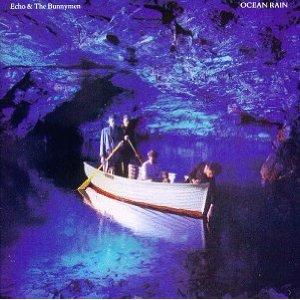
56.
Echo & The Bunnymen
Ocean Rain
[Korova; 1984]
Four albums in, Echo & The Bunnymen made their masterwork. Just ask Ian McCulloch himself. To this day, he still calls “The Killing Moon,” the lead single from Ocean Rain, the greatest song ever written. He doesn’t call it his greatest work, but The Greatest Song Ever Written, and I’d be content not to argue with him. While that song is distinctive, the rest of the album doesn’t lag far behind by any means. Mac himself said in an interview with Max Bell “It was our Michaelangelo’s David, if that’s the one with the arms.” While that’s a bold statement, he wasn’t kidding. It encapsulated everything they’d done to that point, and is really just an outstanding artifact of an overpopulated post-punk field.
– Colin Joyce
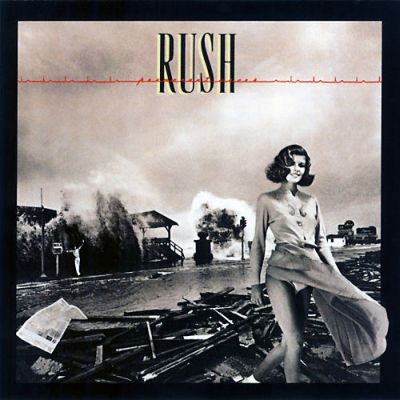
55.
Rush
Permanent Waves
[Anthem / Mercury; 1980]
After 1978’s Hemispheres, Rush had had it with sidelong epics, but they still hadn’t completely abandoned their roots as one of the most technically proficient metal acts around. 1981’s Moving Pictures was the record that completed the Canadian trio’s transformation into one of the more durable album-rock acts of the last few decades, but the previous year’s Permanent Waves put that development on the fast track. Its six songs featured the immortal “The Spirit of Radio,” the equally impressive radio staple “Freewill,” the underrated ballad “Different Strings,” and a couple of more reined-in, but no less potent, extended pieces, “Jacob’s Ladder” and “Natural Science.”
– Sean Highkin
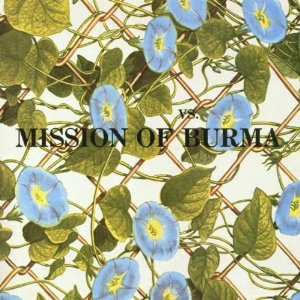
54.
Mission of Burma
Vs.
[Ace of Hearts; 1982]
Mission of Burma split up initially in 1983, citing singer guitarist and co-singer Roger Miller’s complaints of permanent tinnitus. You can look at this two ways: either Miller was a pussy, or Mission of Burma rocked so fucking hard that it was difficult to live through. Within the opening 30 seconds of Vs. it becomes clear that it was probably the latter, and upon hearing Miller’s screamed introduction it’s certain.
The entirety of Vs. is thrilling and essential listen, from the opening powerhouse chug of “Secrets,” through the rising and swelling guitars of “Weatherbox,” and to the howl in the final seconds of the punkishly heroic “That’s How I Escaped My Certain Fate.” Why is Vs. still relevant today? Aside from being at its core a collection of brutally brilliant and well-built rock songs, they also had the added fascination of Martin Swope’s tape loops, which weaved between and melded with the thunderous music. Bassist Clint Conley picked the band name because he thought it sounded “murky and disturbing” – two qualities that are brought to the band’s sound by the tape looping of Swope, whose work on Vs. to this day has rarely been matched.
– Rob Hakimian
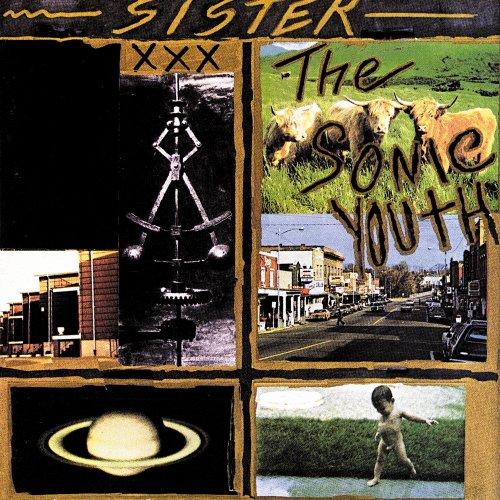
53.
Sonic Youth
Sister
[SST; 1987]
As a general rule, the further back you go in the catalog of Sonic Youth, the harsher things get, and Sister was where things really started to clear up. Here the new-found listenability proved key to some critical and mild commercial success. “Schizophrenia” is certainly amongst the best work of a band with a catalog in which stunning songs are more than plentiful. Here they just seemed to really buckle down and write solid songs, with the little noise jams tacked on, rather than noise jams that begin to take the form of songs. This album certainly begins to foreshadow the success that came later on. There’s no bona fide anthems here, but it’s very clear that we’re moving in that direction.
– Colin Joyce
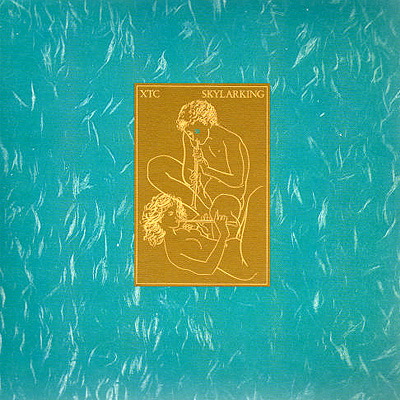
52.
XTC
Skylarking
[Virgin / Geffen; 1986]
For as ambitious and elaborate as XTC’s eighth studio album is, the most impressive thing about it is how naturally everything it tries comes. There’s no straining on the part of principle songwriters Andy Partridge and Colin Moulding, no overreaching to try something out — just a band confidently taking the leap from intriguing, versatile new-wave outsiders to a fully realized, completely formidable pop-rock juggernaut capable of just about anything.
– Sean Highkin
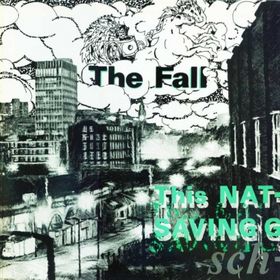
51.
The Fall
This Nation’s Saving Grace
[Beggars Banquet; 1985]
Approaching the Fall’s discography is ridiculously intimidating. Nearly 30 albums make you cower in fear, or maybe have you excited. But a large majority of people who have dug into this brilliant band will be able to tell you that This Nation’s Saving Grace is their finest hour. It’s dark, it’s grimy, and it’s probably what London was in the 1980s. Except for the brilliantly slick, somewhat new wave “L.A.,” the entire thing screams British. Sure, no single song reaches the height of “The Classical,” but the flow and songwriting on This Nation’s Saving Grace are the greatest this band came up with. If you want catchy, anthemic songs, they’re here. “Bombast,” “What You Need,” “Spoilt Victorian Child,” and “Couldn’t Get Ahead” cement themselves in the heads of listeners after first playthroughs. The album wouldn’t be a Fall record without experiments, but “Paintwork,” “Barmy,” and “My New House” fill the role well with the help of the brilliant Can tribute “I Am Damo Suzuki.” Mark E. Smith could ramble on a while over his songs, and This Nation’s Saving Grace just shows why he’s done so for 30 years.
– Ryan Nichols
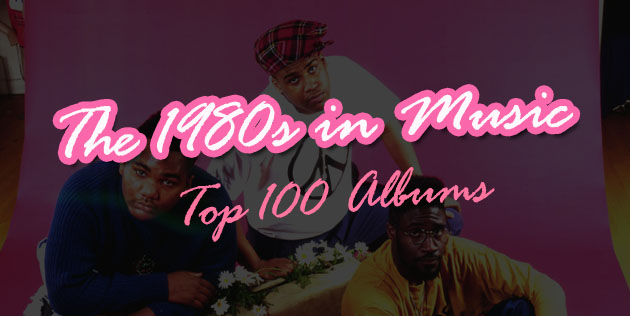

50.
Van Halen
1984
[Warner Bros.; 1984]
Van Halen’s move to keyboards on 1984 should’ve resulted in a ruined career. Not only did the guitar compliment the hard-partying message as a link to the excesses of the 70s on any early Van Halen record, Eddie Van Halen was one of those very rare, very unique pioneers of his instrument; who else, outside of Hendrix, has done as much for the guitar in terms of what it can achieve? No-one. Why move away from that? Remarkably, the move worked for the band. There’s an added dimension to 1984 because of this, a maturity to songwriting that would allow them to keep going, which spilled over into the guitar-only songs. The keyboard reaction may even seem over the top, but when your album opener and single (and arguably best/most recognisable song) are almost devoid of guitar, that’s going to be remembered. As it is, the synth tracks complimented the guitar tracks perfectly, and Van Halen never sounded better than on 1984.
– Daniel Griffiths
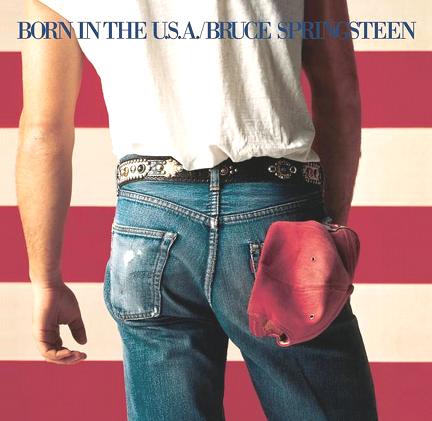
49.
Bruce Springsteen
Born In The U.S.A.
[Columbia; 1984]
Born In The U.S.A. was released in June 1984, but Springsteen had labored on the songs since 1981, with tracks being fully written during the sessions for what became Nebraska – including an early version of the title track. Born In The U.S.A. is in many ways a polar opposite of the sparse and dark Nebraska, with its synths and big, pop-oriented sound. Despite the big and radio-friendly sound the songwriting hadn’t really changed much compared to Springsteen’s previous record with The E Street Band, 1980’s The River, and the lyrics still told the tales of regular, hard-working people, often down on their luck – as exemplified by the often misunderstood title track.
Today Born In The U.S.A. remains one of Springsteen’s most well-known records, and its sound is the one casual fans are most likely to identify with Bruce Springsteen. While a few of the singles may be a bit worn out and the ‘80s production is a bit dated, the strong songwriting throughout makes the record stand the test of time.
– Johan Alm
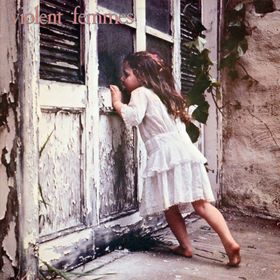
48.
Violent Femmes
Violent Femmes
[Slash; 1983]
Long before Rivers Cuomo was perfecting being, ya know, Rivers Cuomo, Violent Femmes mastermind Gordon Gano was synthesizing the art of being oddly solipsistic and colorfully creepy better than just about anybody could want to. Musically, his band’s self-titled debut would employ a punk rock spirit expertly straddling the lines of alternative, folk, and pop (all done with barely any electronics!); but the album’s demeanor is what left its most notable mark. Juxtaposing those world-class hooks with… fucking weird sexual confessions and unabashed self-aggrandizement, Violent Femmes was a unique celebration of feeling completely comfortable with being overtly uncomfortable. It’s not that anything contained within Violent Femmes was particularly offensive, but there is something to be said about the simple art of having little to no tact. Ultimately, it makes for a wildly enjoyable and shockingly affable LP which contains some of the more addictive hooks and songs of the 1980s.
– Daniel Rivera
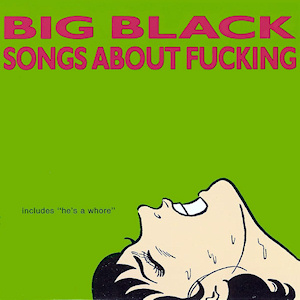
47.
Big Black
Songs About Fucking
[Touch & Go; 1987]
Even Steve Albini’s loudmouthed antics can’t overshadow his work as an artist and recording engineer (he’s responsible for everything from Surfer Rosa to Ys). Throughout the ‘80s, Albini offered no apologies for Big Black’s subject matter, and naming his next band Rapeman after the title character in a Japanese comic book didn’t dissuade misogyny claims. On Big Black’s final album, Songs About Fucking, they cram songs about assholes (“Bad Penny”), the unfortunate cure to the “sleepy sickness” epidemic (“L Dopa”), sexual dominance (“Precious Thing”), and humiliating execution methods (“Columbian Necktie”) into a tight half-hour package. And that’s only side one. Working like an efficient lumber mill, the drum machine laid an aggressive backbone to the whirring fury of electric guitars. Side two eases up by their standards, especially on “Tiny, King of the Jews” which features subdued, distant vocals that still manage to be menacing. But on “Fish Fry,” Albini steams as he depicts a murderer hosing the blood from his pickup truck with his “8-track playin’ really fuckin’ loud.” Ah, Albini: always the analog loyalist.
– Michael Tkach
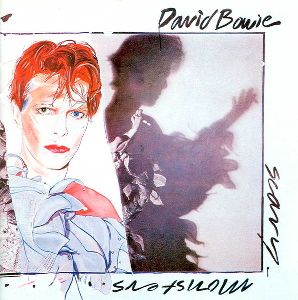
46.
David Bowie
Scary Monsters (and Super Creeps)
[RCA; 1980]
David Bowie capped off one of the all-time great stretches of albums in rock history with this one. Scary Monsters used Bowie and Brian Eno’s peerless Berlin Trilogy as a foundation, refining those records’ art-rock experimentation while also hinting at the direction Bowie’s career would take in the rest of the ‘80s. For the first time in his career, Bowie slipped from relevance during this decade with a series of increasingly predictable and overtly radio-baiting records, but on Scary Monsters tracks like “Ashes to Ashes” and “Fashion,” he proved that “commercial” and “forward-thinking” weren’t meant to be mutually exclusive. He’s made some solid albums in the years since Scary Monsters, but this was his last truly great piece of work, and it ranks as one of his very best.
– Sean Highkin
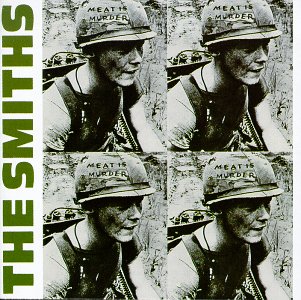
45.
The Smiths
Meat Is Murder
[Rough Trade; 1985]
Politically charged and loaded with in-your-face sensitivity, Meat Is Murder may not get the same level of love as followup The Queen Is Dead, but is more than worthy. For the self-produced Meat Is Murder, The Smiths took the best ideas from their debut and perfected them, resulting in two of their best and most anthemic songs “I Want the One I Can’t Have” and “The Headmaster Ritual.” Conversely, the band tried out some ones, thus pushing them along the path to becoming one of the most important bands of not just the ‘80s, but ever. Whether adopting a rockabilly style on “Rusholme Ruffians” or going funky on “Barbarism Begins at Home,” the guitar chops of Johnny Marr on Meat Is Murder are never anything less than impeccable, redeeming what would have otherwise been a lachrymose ode to vegetarianism on the title track.
– Frank Mojica
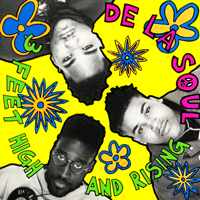
44.
De La Soul
3 Feet High And Rising
[Tommy Boy / Warner Bros.; 1989]
Perhaps best known to the masses for being featured in the recent Tribe Called Quest documentary, De La Soul has a reputation among true hip-hop heads for being the one group there will never be a movie about. Their consistency throughout their 11 albums has been their greatest gift to the music world. They have continued to grow as artists without compromising their integrity. Posdnuos, Dave & Maseo played an instrumental part in the early days of the Gorillaz and have toured with alternative bands like Modest Mouse & Flaming Lips.
It all started with 1989’s 3 Feet High and Rising. From the album cover to the music, De La Soul didn’t fit the generic hip-hop mold of the time. They were wearing weird/vintage clothes (before that was a thing) and all about daisies; a stark contrast to popular acts at the time like the Geto Boys & Ice T. My personal favorite song from the LP, “Eye Know” sampled Steely Dan’s “Peg” long before Kanye West had the idea to sample Donald Fagen & Walter Becker.
Today the album is in the National Library of Congress and it was recently paid homage to in a Nike SB campaign. Without 3 Feet High and Rising and the Native Tongues Movement, artists like Kanye West & the Neptunes would never have been possible.
– Marc Heilbrunn

43.
The Replacements
Tim
[Sire; 1985]
The Replacements’ 1985 major-label leap, Tim, could end any argument about majors versus indies in a band’s creative process, as the album maintained the band’s fierce integrity and commitment to quality that had previously been reached on Let It Be. Containing a fair share of classics, including “Left Of The Dial,” “Bastards Of Young,” and “Hold My Life,” the album portrays a slightly more poppy version of the band, moving further away from their hardcore roots and even containing a hilarious (and particularly ’80s in content) ode to stewardesses on “Waitress In The Sky.” But at their heart, The Replacements had hardly changed at all, seeing very little commercial exposure with their major label debut and even squandering an appearance on Saturday Night Live in 1986 by receiving a lifetime ban from the show following their rebellious performance. Luckily people liked, and still do like, writing about The Replacements, who were forever doomed to be little more than critic’s darlings.
– Philip Cosores
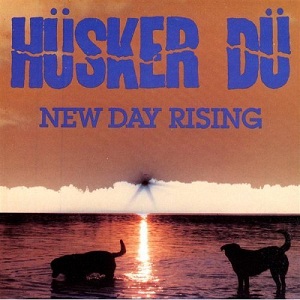
42.
Husker Du
New Day Rising
[SST; 1985]
While fellow Minnesotans The Replacements were jumping to the majors, Hüsker Dü was following up their most ambitious album, Zen Arcade, with the more straight-forward and, arguably, more easily enjoyable classic New Day Rising. And, it was released a mere six-months later. Seamlessly blending their hardcore punk roots with a then nameless, later-to-be-called-alternative leaning, New Day Rising showcases Bob Mould’s pop sensibilities (“I Apologize,” “Celebrated Summer”) with Grant Hart’s underrated songwriting successes (“The Girl Who Lives On Heaven Hill,” “Books About UFOs”). It’s easy to look at New Day Rising and wonder if any of the college rock of the Pixies or the grunge of Nirvana would have been possible without Hüsker Dü, but it is probably better to enjoy the record for what it is: a thesis in the aesthetic of working-class punk and the realization that melody and attitude don’t have to be combative elements. At least, not anymore.
– Philip Cosores
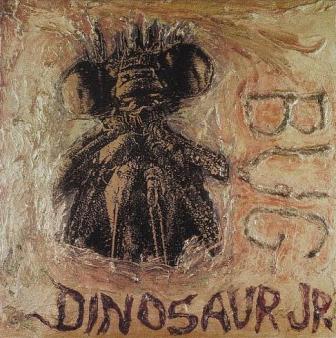
41.
Dinosaur Jr.
Bug
[SST; 1988]
As one of the more consistently active bands to have their roots in the ‘80s, we’ve seen many incarnations of Dinosaur Jr. across the years, and still nothing has beaten the original late ‘80s lineup. Bug, the last before the strife, before the ego and perfectionism that drove Lou Barlow and eventually Murph away, sounds like a young band at their best, and certainly doesn’t seem to predict Barlow’s leaving a short time later. Barlow’s melodic, guitar-like bass lines, Murph’s keen sense of dynamics, and J Mascis’ ever-improving songwriting and guitar playing combine for some outstanding moments. The noisy solo in the outro of “No Bones,” the catharsis of “Pond Song” — it’s just all outstanding. There’s certainly a reason that everyone was excited when Beyond was announced in 2007; this lineup here is amongst the greatest we’ve ever seen, and despite the fact that it was all about to fall apart, they just sound locked-in.
– Colin Joyce

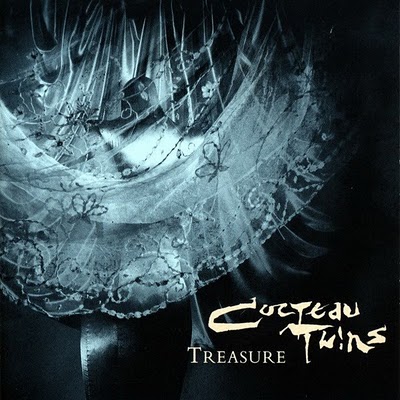
40.
Cocteau Twins
Treasure
[4AD; 1984]
Some albums are quintessential to the time from which they came, but Treasure is not one of these albums. Rather, it manages to sound as something almost existing in its own self-contained state of being almost three decades later. Although Treasure follows two albums and four EPs, it is truly when Cocteau Twins came into their own as a genre-defining band. Along with new bassist Simon Raymonde, Robin Guthrie unleashes layer after layer of effect-laden guitars, while Elizabeth Fraser’s unearthly, ethereal voice soars in all its indecipherable glory, reaching new emotional heights. Although self-produced, the spirit of Phil Spector is ever-present on this collection of pop gems awash in a sea of noise. Treasure is a dream-pop masterpiece full of what would later be called “4AD-isms.”
– Frank Mojica

39.
Rush
Moving Pictures
[Anthem / Mercury; 1981]
They say that every band has its masterpiece, yet, it’s very rare that the album ranks as just that in wider world. Moving Pictures is an exception to that rule; an album that can be spoke of in the same sentences as Back In Black, IV/Zoso and Exile On Main St. Starting with “Tom Sawyer,” Rush managed to write some killer tunes and flex their musical muscles through “Red Barchetta,” “YYZ” and “Limelight” while keeping their audience engaged, then change the direction of the record until you get to “Vital Signs” which is as far removed from the opener as is possible. The real treat though, is the attention to detail in Moving Pictures. Peart’s lyrics are a step above his previous writings, the drumming is concise and still as brilliant, Geddy Lee is Geddy Lee, but better, and Alex Lifeson quite simply shines – check the guitar out in those first four tracks: Stunning.
– Daniel Griffiths
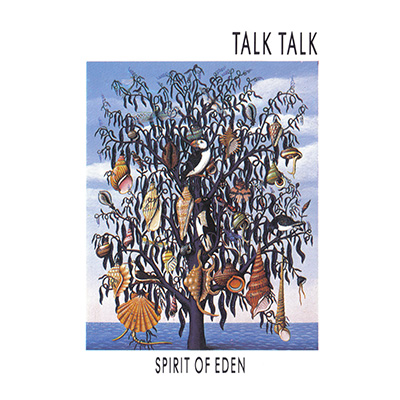
38.
Talk Talk
Spirit of Eden
[Parlophone / EMI; 1988]
Atmospheric, beautiful and always begging to replace the album you’re currently hearing: this is the leap into the unknown that Talk Talk took after vaguely hinting at what was to come on their commercial hit album The Colour of Spring. It’s a bit embarrassing to say an album titled Spirit of Eden is ‘spiritual,’ but that’s how it pans out. These tracks aspire to higher plateaus of enlightenment like John Coltrane’s watershed free jazz album Ascension. There’s a reason Talk Talk never toured after ’86: to do so would undermine the spontaneity and lose sight of its purity, according to Mark Hollis.
Critics peg this masterpiece as a distinct influence for post-rock, yet Tim Friese-Green’s crisp production and Hollis’ vocals remain unmatched by anybody else. On Laughing Stock, they return to this technique once more before turning in. Mark Hollis’ 1998 self-titled debut provides a minimal take on the proceedings, but there’s very little that can top the transcendent final two Talk Talk albums. “The Rainbow” signifying the beginning of a great thing, while Spirit of Eden as a whole draws on ambient flourishes and dynamic shifts to create pure sonic bliss.
– Michael Tkach
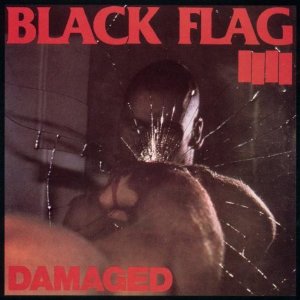
37.
Black Flag
Damaged
[SST; 1981]
It’s downright impossible to have a discussion about the early hardcore movement, and not highlight Black Flag’s seminal LP Damaged. A masterpiece of anger and shattered identity, Damaged is one of the boldest debut albums to ever be released; and not just because of its noisy, introspective, aggressive demeanor. A perfect example of the DIY method so prevalent among independent music in the early ’80s, Damaged (released on their own label) found a perfectly invigorated Black Flag essentially redefining what the hardcore sound was. The band notably wrote all of their songs primarily in slower tempos as to add the pertinent melodies or “swing,” before speeding them up to incorporate the cutthroat, smash mouth aura with which they would become synonymous. The result is a uniformly energizing display of military-like precision and discipline set atop a chaotic mess that could not have come from any other band at the time.
– Daniel Rivera
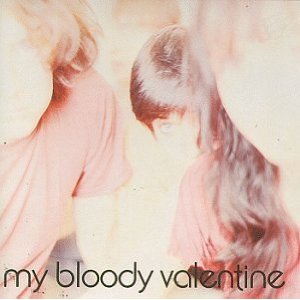
36.
My Bloody Valentine
Isn’t Anything
[Creation / Relativity; 1988]
Although the band of elusive (and reclusive) frontman Kevin Shields is best known for their 1991 effort Loveless, it is the band’s debut album that shows their full range and capability. It’s the band’s only effort that fully dabbles in the uncanny and the coarse and where Shields manages to perfectly combine ‘60s pop and punk anthems. Isn’t Anything may include My Bloody Valentine’s most personal material, and proves that a record doesn’t need to be excessive to be perfect.
– John Wohlmacher
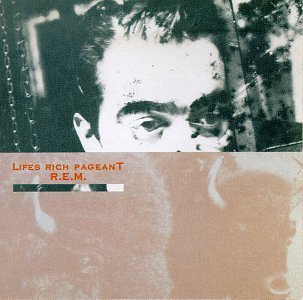
35.
R.E.M.
Lifes Rich Pageant
[I.R.S.; 1986]
The energy and vivacity of Lifes Rich Pageant’s opener “Begin The Begin” help set the scene for the rest of the album. The opener is a statement of intent from R.E.M. and you get the feeling the band are locked-in, focused on crafting something special. They don’t disappoint on Lifes Rich Pageant. While this is still R.E.M., there’s something a little different about them on the album, as if someone served up a little adrenalin with their coffee while they were at the mixing desk. Lifes Rich Pageant is also where Michael Stipe, for me, really comes into his own as a lyricist. There’s an element of activism that creeps up in certain songs, both political and ecological. Stipe’s storytelling also becomes so much more focused and detailed than before. Couple this with Peter Buck’s ever-beautiful chiming chords, you have an album that allows its listener to lose themselves completely in it.
– Daniel Griffiths
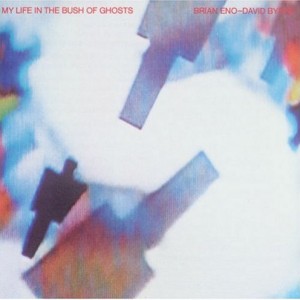
34.
Brian Eno & David Byrne
My Life in the Bush of Ghosts
[Sire; 1981]
As they say, everything is a remix. Sampling is a conduit to artistic influence, and with that in mind, Brian Eno and David Bryne weren’t exactly breaking new ground on My Life in the Bush of Ghosts. Bryne’s biggest group, Talking Heads, released the Third World trotting, critical darling Remain in Light, only one year prior. Yet recording sessions for Bush of Ghosts began before Remain in Light was recorded. As such, Bush of Ghosts can be viewed as a precursor to the artistic peak of Talking Heads along with Eno’s greatest ambient achievement, Ambient 4: On Land, but it’s certainly not to be overlooked.
The sampling on the album – which ranges from radio hosts to Lebanese mountain singers to evangelists to Egyptian singers to Algerian Muslims chanting the Qur’an (removed by the second edition at the request of the Islamic Council of Great Britain) – is easily the most varied, accomplished work prior to Paul’s Boutique. It is a pioneering effort that dispels superficial notions of ethnocentrism in Western music. That aside, even the percussive layers that pervade this album are praise-worthy, and consequently, My Life in the Bush of Ghosts is much more than a footnote within these legendary artists’ careers.
– Michael Tkach
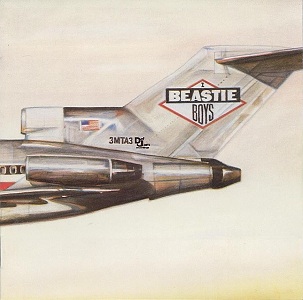
33.
Beastie Boys
Licensed to Ill
[Def Jam / Columbia; 1986]
It’s kind of ridiculous how close the Beastie Boys came to spending the rest of their careers as proto-Ali G-esque caricatures minus the self-awareness. It’s ostensibly way easier to criticize Licensed to Ill, because, on the surface, here were three white teenagers adopting these short-sighted ghetto-personas, and reaping the rewards of all the hard work done by hip-hop’s forefathers. You get the sense that Beastie Boys fans, as well as the group itself, should constantly be apologizing for this record, but no one does, and rightly so (amends have been made, but the record’s never been disowned). Because for all its, and their, faults, Licensed to Ill is a hip-hop touchstone, from Rick Rubin’s classic rock-sampling production to the over-the-top rapping. Listening to songs like “Rhymin & Stealin” or “Paul Revere” or “Hold It Now, Hit It,” the masks and branding fall away, and you see three kids who honestly, truly, care about hip-hop, and have the ability to take it somewhere great.
– Jon Blistein
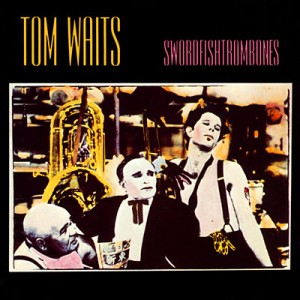
32.
Tom Waits
Swordfishtrombones
[Island; 1983]
Before Swordfishtrombones, Tom Waits was known for his piano ballads and jazzy spoken word pieces. This was the album that formed the eccentric Tom Waits we know today. Tales of suburbanites burning their houses to the ground replaced drunken crooning about hookers in Minneapolis.
Songs like “16 Shells From A Thirty-Ought Six” and “Gin Soaked Boy” emanate Howlin’ Wolf through foot-stomping blues. “Shore Leave” and the title track place the listener in some dark cabaret. Instrumental tracks “Dave The Butcher” and “Just Another Sucker On The Vine” drum up images of gritty carnivals and romantic, cobblestone streets, respectively of course. The album’s closing song, “Rainbirds,” is a jazzy number that’s ripe with emotion, perfect for a rainy day. The title hinted at what Waits’ next album would be called, Rain Dogs.
Swordfishtrombones showed a rejuvenated Waits evolve out of the lounge act he had become known for into an even more brilliant artist.
– Nicholas Preciado

31.
U2
War
[Island; 1983]
War marks a short but very rewarding point in the timeline of U2. In their previously releases, U2 had yet to figure out how to coalesce their message and their music. Later on, the band would resort to slowing down tempos to provide Bono the maximum amount of time at the podium. However, on War, political messages are shot out rapid fire. Opening salvo “Sunday Bloody Sunday” begins with Larry Mullen Jr.’s battlefield drum march, the appropriate segue into the song’s Bloody Sunday massacre lyrical theme. The subject of battle and revolution are omnipresent on War as tracks “Seconds” (“Held to ransom, hell to pay, a revolution everyday”) and “The Refugee” (“Her papa go to war, he gonna fight but he don’t know what for”) attest. Thematically, the album is not just one dimensional; the new wave-y “Two Hearts Beat As One” is one of the band’s most obvious come-ons, and “Red Light” is basically U2’s rewrite of “Roxanne.” When considered in its entirety, War is U2’s first complete statement as well as their most straightforward hard rock album.
– Jason Hirschhorn

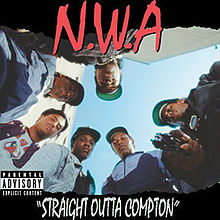
30.
N.W.A
Straight Outta Compton
[Ruthless / Priority / EMI; 1988]
Straight Outta Compton is something of a rarity: a gangster album without morals. Marking the first of its kind, N.W.A. thoroughly embraced the troubled society where gangsters came from – ethical or not. Their debut record didn’t so much provide an entertaining listen but a challenging set of songs that conveyed the harsh realities of urban America. Its re-occurring themes of over-authority and racist environments unified the project as an all-too-rare political record. Instead of opposing the crimes, Ice Cube and co. took part in them within the context of their narratives. While songs like “Fuck tha Police” and “Gangsta Gangsta” certainly consist of the profanity and sexism that critics lash out against to this very day, the MCs themselves are fascinating protagonists : more in love committing the felonies than enveloping the swagger.
– Ryan Studer
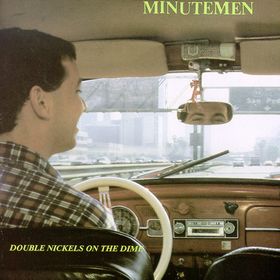
29.
Minutemen
Double Nickels on the Dime
[SST; 1984]
One Thirty BPM ranks this album 29 on its list of the top albums of the 1980s, but I disagree. I submitted a form with this record ranked in all slots 1-100, and I may have even sent more than one. I think Evan threw them out. Really this album deserves the rank of “infinity” because even if it came out today it would be so stupidly ahead of its time. A relentless cross-country tour of experimentation, arrangement and poetry, Double Nickels on the Dime occupies sonic and emotional space new listeners never knew was there. It’s long, but individual highlights reveal themselves like instant friends that see you sitting on the beach by yourself and ask if you want a cigarette and a ride to the party their friends are throwing a town over. “Punk rock changed our lives.” Ours too.
– FM Stringer

28.
AC/DC
Back In Black
[Albert / Atlantic; 1980]
Here’s a question: As a band, how do you cope with the loss of your talismanic frontman, the focal point of the band in every way, shape and form? You craft the second biggest selling album of all time and the yardstick by which any future hard rock album is measured by, of course. How AC/DC could top an album as good as Highway To Hell is beyond me, but they did it, and with style. Almost every aspect of the band’s performance is improved, with the exception of the double entendre that Bon Scott perfected. Back In Black is a different AC/DC for a different time though, one where Angus Young took centre stage and carried the band to superstardom, and the band promptly shifted their focus from lyrics to hard-hitting riffs to back that up. You wouldn’t blame AC/DC if they had called it quits after Bon, but imagine a life without Back In Black. Hard, isn’t it? That’s why it’s on the list.
– Daniel Griffiths
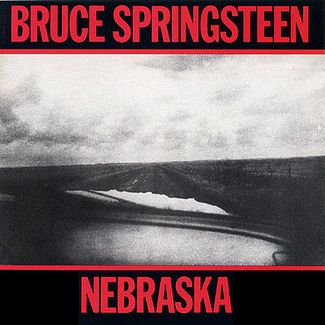
27.
Bruce Springsteen
Nebraska
[Columbia; 1982]
In the catalog of Bruce Springsteen, Nebraska sticks out like a sore thumb, probably because the album is the result of one of the more famous accidents in rock and roll history. Recorded as demos for an E-Street Band album, the Howard Zinn-inspired tales of working-class economic struggle, violence, and clashes with authority ended up sounding better as the four-track, stripped-down, The Boss-alone-with-his-guitar-in-a-basement versions that you now hear on the 1982 album. Yeah, I’m sure one day we’ll hear the fabled ‘Electric Nebraska,’ but for now, let’s appreciate the twelve-bar-blues romp of “Johnny ’99,” the heartbreaking tale of two very different brothers in “Highway Patrolman” (famously turned into the film The Indian Runner by Sean Penn), and the opening title-track of a killing spree that takes its source material from the same story as the films Badlands and Natural Born Killers. And, of course, there is the beloved “Atlantic City,” which is great for many reasons, namely the refrain “maybe some things that die someday come back.” I’m sure it would have sounded wonderful with a saxophone solo, but it sounds perfect as a spare and intimate reflection by a lone Springsteen.
– Philip Cosores
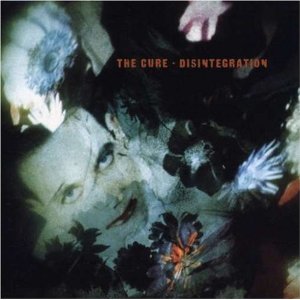
26.
The Cure
Disintegration
[Elektra; 1989]
After three records of (mostly) uplifting new-wave pop, Robert Smith decided to return to the baroque songwriting formula of The Cure’s “doom & gloom“-era, and made what could be regarded as the band’s Abbey Road. Disintegration is overflowing with ideas and creative twists, dabbling in ambient, pop and post-punk, alternating between gothic symbolism, romantic daydreams and existential dreamscapes. Although Smith preceded and followed the record with double-albums, Disintegration marks the moment where The Cure achieved all they ever set out to do.
– John Wohlmacher
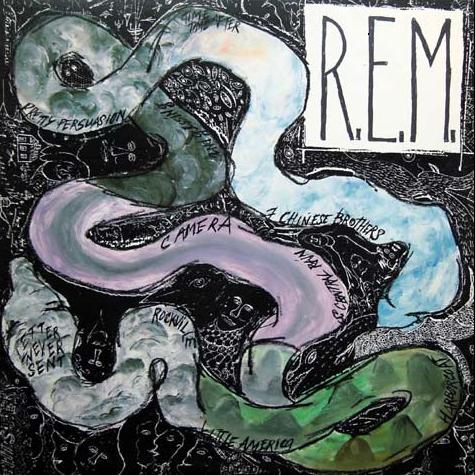
25.
R.E.M.
Reckoning
[I.R.S.; 1984]
I must confess that I feel a little bit strange writing about music from the ‘80s. Having been born right after this decade’s conclusion, I have no recollection of what it was like when these records came out. But of all the groups that got their start before 1990, R.E.M. is the one that I identify with the most. Their chemistry is simply unlike any other group that has existed before or since. Reckoning was released less than a year after the game-changing Murmur, and it was nearly as good. Michael Stipe was still singing close to the chest at this point, protecting his words from becoming totally audible, the music is a little more confident, and the artistic growth on display is incredibly satisfying. So before it became a cornerstone of one of the most amazing runs by any band in the last half-century, I’d say it was probably just an excellent album by an exciting and very promising young band.
– Brendan Frank
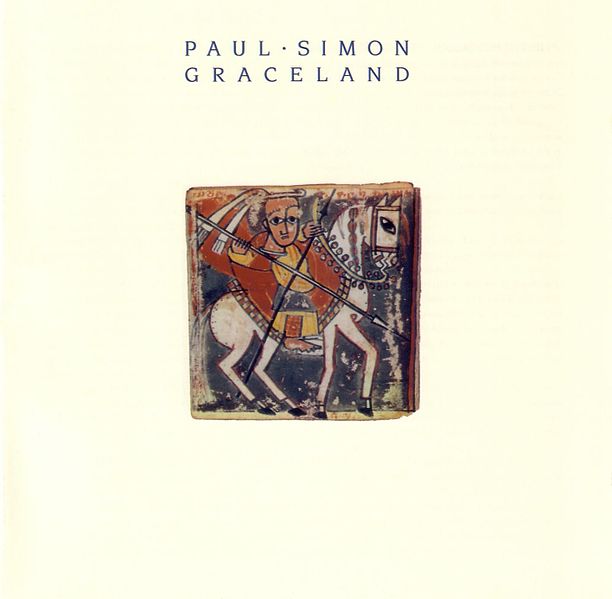
24.
Paul Simon
Graceland
[Warner Bros.; 1986]
By the time Graceland was released in 1985, Paul Simon had already had multiple careers: as a successful folk act in the 1960s with Simon and Garfunkel, as an acclaimed solo act in the 1970s, and as an artist struggling for inspiration and seeing his commercial appeal dip in the 1980s. But Graceland is more than a comeback album, though it did nab Simon Grammys for both Album Of The year and Record Of The Year for the title track. Like Peter Gabriel around the same time, Simon proved the viability of world music as a commercial commodity, using his time in South Africa to expose an American audience to sounds and rhythms that they might not be wholly familiar with. And its lasting influence seems to just be showing its face, with bands like Vampire Weekend taking the ideas to the logical next step, a generation later. But I go back to the opening song, with the particularly timely lyrics about “lasers in the jungle and the baby with the baboon heart.” Simon’s lyrics about globalization and the rapid modernization of the planet are one of the more underrated aspects of Graceland, something he isn’t totally critical of, concluding that “these are the days of miracles and wonder.”
– Philip Cosores

23.
Husker Du
Zen Arcade
[SST.; 1984]
There are a lot of “bad” words associated with that which exploded from the Dü. Words like “emo” and “sincere” and, most offensive of all, “AMBITIOUS.” They are referenced in more than a few bad songs and the record in question, the completely fantastic Zen Arcade, is a concept album about a boy leaving home and returning even more unfulfilled, more disillusioned. The fucking audacity. Sometimes I think that Hüsker Dü should be punished for being in the MySpace “influenced by” column of all of those bands I went to high school with, but then I remember the bass guitar lines like trains over pennies, the swerving pitchbends on guitars that threaten to gnash out of control, the impossibly effortless hooks. And really, I guess it’s okay that the album existed for new generations of songwriters. A narrator rubber-banded home after hating the world outside? The Monitor. Piano interludes and genre meandering? Source Tags and Codes. Fuck you, Hüsker Dü! You’re all right after all.
– FM Stringer
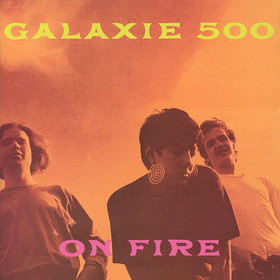
22.
Galaxie 500
On Fire
[Rough Trade; 1989]
On Fire is the very study of refinement. No one is ever going to prop this record up as revolutionary. Basic guitar rock rooted in The Velvet Underground garage slop is both the ends and the means here. Galaxie 500 simply realized the potential promised on Today with ten songs of achingly tender melodies and Dean Wareham’s earnest falsetto guiding the proceedings into unexpectedly affecting territory. At its heart On Fire wants nothing but to be an album of guitar driven pop, but the subject matter, which touches seamlessly on everything from Twinkies to states of longing, and the emotional focus turn the record into something transformative.
– Will Ryan
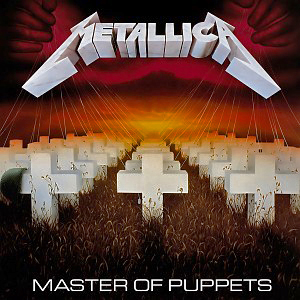
21.
Metallica
Master Of Puppets
[Elektra / Music For Nations / Vertigo; 1986]
When Metallica released the eponymous “Black Album” in 1991, hardcore metalheads bristled at the increased attention paid to singable choruses and stadium-sized riffs at the expense of the intricate, acrobatic contributions that had defined the San Francisco thrash pioneers’ first four albums. In truth, however, Metallica’s penchant for hooks existed as far back as their 1986 high-water mark, Master of Puppets. The move away from pure thrash-metal had begun on the group’s sophomore album, Ride the Lightning, but Puppets showcases a more mature Metallica. The thought put into the album’s sequencing and pacing is as much the story here as Kirk Hammett’s shredding pyrotechnics or Lars Ulrich’s machine-gun percussion. Bassist Cliff Burton, who was tragically killed in a bus accident following the release of Master of Puppets, holds down the bottom end in a way that neither of his subsequent replacements have quite managed. Puppets isn’t just Metallica’s best work — it’s the greatest heavy metal album ever made.
– Sean Highkin

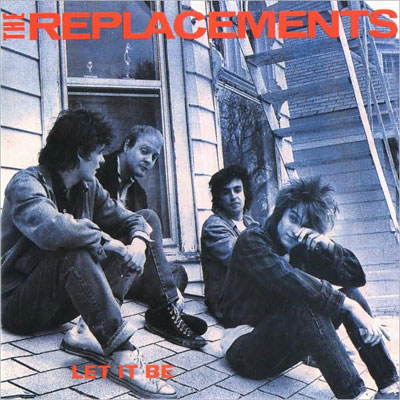
20.
The Replacements
Let It Be
[Twin/Tone; 1984]
OK, so at this point what else can I really say about Let It Be? We all get it: It’s The Replacements’ best record because you can hear so clearly hear them grappling with their drunk punk rock past and imminent college rock future. So let’s get the whole seriousness-juxtaposed-with-goofiness stuff out of the way, because, duh, if you can write a song called “Gary’s Got A Boner” and then have it transition perfectly into “Sixteen Blue” — a song so honest in its approach to adolescent frustration and confusion — if you can do that not just once, but throughout an entire LP, then yeah, you deserve to be in the pantheon. Let It Be showed that nothing was sacred — punk rock, Beatles albums, sincerity, humor — that anyone, anything, can and should be screwed with because isn’t that what rock and roll is all about? And, yes, in canonizing Let It Be right now we’re certainly guilty of those aforementioned crimes against rock, but I suppose it is about finding a balance. So for a second forget the whole “turning point of a band” narrative, forget the juxtapositions, forget the indie rock oeuvre, and just think about the shuffling guitars of “I Will Dare” or the intoxicated anger of “We’re Coming Out,” or the exhilaratingly stupid joy of “Tommy Gets His Tonsils Out,” or the sweet paean of sexual freedom that is “Androgynous,” or the fact that “Black Diamond” is a freaking KISS cover, or Westerberg’s choked-up wail on “Unsatisfied,” or the anthemic titular chant of “Seen Your Video,” or the lonesome, heart-wrenching beauty of “Answering Machine.” Because that’s what makes Let It Be perfect.
– Jon Blistein
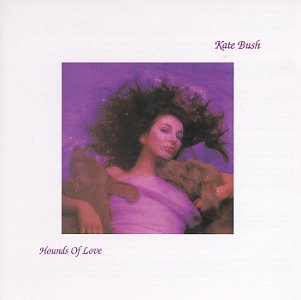
19.
Kate Bush
Hounds Of Love
[EMI; 1985]
There comes a time in your life when you enter adulthood, and as you find footing, you go and find an incredible artist who makes you feel terrible about yourself. Regardless of whether you’re an artist or a simpleton who simply admires art, you feel as though whatever you do, you absolutely cannot compete with someone so great. Cue Kate Bush.
Hounds Of Love is split up into two sections: “Hounds of Love” and “The Ninth Wave.” The first section consists of upbeat, pop-friendly songs, and the second section is an exploration into Kate’s more left-field sensibilities. It has Celtic folk, songs about witches and drowning, programmed looping and advanced layering — and this was on a major label album by a major female artist. Hounds of Love ushered in a new age of avant-pop that has been carried on by Björk, Tori Amos, and PJ Harvey, among others. Ask yourself: would our modern artists be taking risks, if not for this album and others like it? It’s time to bow down.
– Arika Dean
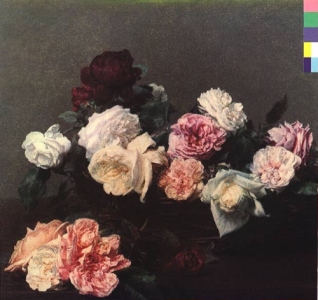
18.
New Order
Power, Corruption & Lies
[Factory; 1983]
They say lightning never strikes twice, but that’s precisely what happened when New Order released their sophomore album, Power, Corruption and Lies, in the summer of 1983. After suffering through the tragic loss of Ian Curtis and the subsequent dissolution of Joy Division, the simple act of regrouping would have been an impressive enough feat for most artists. But as evidenced in this record and the ones that followed, the creation of New Order was much more than just a regroup – it was rebirth.
From the opening notes of “Age of Consent” and onward, Power, Corruption and Lies is the soundtrack of a band taking hold and never letting go. It is here that the group fully developed their signature sonic identity – trading in Joy Division’s post-punk darkness for a synth-led reinvention that would inspire countless acts throughout the decades. It’s incredibly difficult for musicians to create a sound that is vital, unique, and influential. This album proved that Peter Hook, Bernard Sumner, and Stephen Morris could do it twice.
– Cole Zercoe

17.
Dinosaur Jr.
You’re Living All Over Me
[SST; 1987]
You’re Living All Over Me isn’t just the best thing rock legends Dinosaur Jr. ever put out, but it’s one of the least heralded catalysts for the so-called grunge movement that would change the face of music in the 1990s. The way the band brought together violent, brain-rattling fuzz-rock and somber dream pop is practically unmatched. Hell, most bands wouldn’t have survived the mere opening seconds of an album like this. When You’re Living All Over Me starts, it’s nothing but a thick barrier of distortion, feedback, piss and vinegar. But somehow, J Mascis even pulls that off. And once the static gets a chance to dissipate, what’s left is one of the seminal records of not just the 1980s, but of a whole genre.
– Andrew Bailey

16.
Pixies
Surfer Rosa
[4AD; 1988]
To understand the impact of Surfer Rosa, one only needs to review the alternative explosion of the nineties. The Pixies’ “soft verse, loud chorus” songcraft was near omnipresent for the first half of the nineties, by which time the Pixies had already burnt out and subsequently disintegrated shortly thereafter. But back in 1987, the band was fresh off the critical success of their debut EP Come On Pilgrim and were being matched up with the still somewhat unknown producer, Steve Albini. The resulting Surfer Rosa had a harder, more menacing edge than anything any other alternative rock band was releasing at the time. On “Bone Machine,” every part of what came to epitomize the Pixies is on display: Black Francis’ offhand remarks left in the final mix, the off-key vocal harmonizing of Francis and Kim Deal, and the sludgy bass and drums that were a breath of fresh air from the overproduced eighties’ rhythm sections. On Surfer Rosa, the band is just having fun and not taking themselves overly seriously. The Pixies were just different, and nowhere is this better exemplified than the moment on “Where Is My Mind?” where all the instruments and voices fall off save Deal’s ghostly howl. Still to this day it’s the most simultaneously haunting and funny moment in popular music.
– Jason Hirschhorn
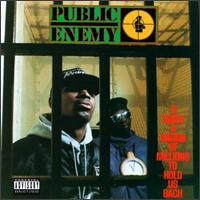
15.
Public Enemy
It Takes A Nation Of Millions To Hold Us Back
[Def Jam / Columbia; 1988]
More than anything else, especially now in hindsight, the ’80s harbored a great number of artists that served as transitional figures from one decade to the next. While many artists on our lists could be categorized as similarly influential, few had the audacity and tenacity of Public Enemy. It Takes a Nation of Millions to Hold Us Back will forever be memorialized for its stance on race relations and sociology, but musically it was one of a kind. The mix of live performance, bombastic cuts and loops, along with the progressive idea of sampling combined to make an album wholly a product of the time, yet incredibly ahead of the curve.
– Erik Burg
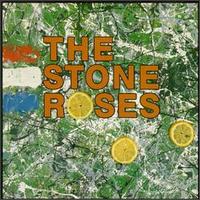
14.
The Stone Roses
The Stone Roses
[Silvertone; 1989]
Self-described by singer Ian Brown as “the most important group in the world,” The Stone Roses debut LP kicks off to the tune of a locomotive building steam on “I Wanna Be Adored,” and transitions gradually into the thick, textured foundation of Gary Mounfield’s bass. Bouncy, up-tempo “She Bangs The Drums” features guitarist John Squire’s nimble digits blurring across strings and frets. Atop fuzzy reverb, Brown belts in fervid frenzy: “Have you seen her have you heard/ The way she plays there are no words/ To describe the way I feeeeeel!” Building on this theme of smitten infatuation, “Waterfall” has Brown conceiving his lover as a surging naturalistic force amidst cascading guitar riff. On “Bye Bye Bad Man,” a playful shaker and Squire’s sunshine-laden finger picking clash with Brown’s sprightly lyrics. Channeling John Lennon’s “Run for Your Life,” The Stone Roses’ “Shoot You Down” has the Manchester natives fantasizing about unleashing a barrage of bullets upon a manipulative minx. The instrumental section cuts out abruptly, leaving only a dead silence to complement Brown’s eerie purr of frigid detachment: “I’d love to do it and you’ve known you always had it coming.”
A slew of garish guitar licks and electronic effects set the backdrop for psych-rock ditty “Made of Stone,” as the vocalists’ rhetorical questions reveal a thinly veiled preoccupation with alienation and decay. By far the LP’s longest cut at over eight minutes, “I Am The Resurrection” is an uninhibited guitar-driven rocker that rips into an erstwhile companion with mocking chides.
As trailblazers in the “Madchester” movement that wed dance rhythms with melodic guitar pop, The Stone Roses remain one of Britain’s national treasures.
– Henry Hauser
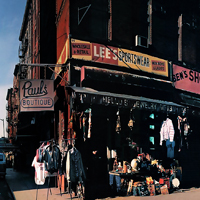
13.
Beastie Boys
Paul’s Boutique
[Capitol; 1989]
Despite having a widely successful debut with Licensed to Ill, the Beasties broke ties with Def Jam and Russell Simmons due to unpaid royalties and parted ways with producer Rick Rubin to avoid being overshadowed artistically. The three Jewish kids from New York soon found themselves in Los Angeles where they signed to Capitol and teamed up with producing duo The Dust Brothers. A stay at director Alex Grasshoff’s house (the “G-Spot”), endless eggings, and a quarter million dollars worth of samples later, the Beastie Boys had one of the most prolific and technically impressive hip-hop albums of all time on their hands.
The multitude of samples (literally hundreds sprawling across the genres of funk, soul, hip-hop, and rock) used by the Dust Brothers was unheard of at the time, and due to changes in sampling law (back in 1989, drum samples didn’t need to be cleared) a commercial release using so many many samples just wouldn’t be viable. Who today is crazy enough to sample five Beatles songs on a single commercial track? (See “The Sounds of Science”).
Take a look a more recent sample-heavy albums: Girl Talk’s releases are released under non-commercial Creative Commons licenses and are made available for free download. 2000’s Since I Left You by Australian group The Avalanches had many of its samples swapped out or removed before it could see wide release.
The Beatles ties don’t end stop at its samples. Due to Paul’s Boutique‘s psychedelic elements and ending medley it can be seen as both rap’s Sgt. Peppers and Abbey Road. Even though Paul’s Boutique has just passed its 20th-anniversary it seems like rap fans will hold it on a very similar echelon. In just 53 minutes, the Beastie Boys — and Dust Brothers — take us on a journey from Los Angeles to New York while paying homage to years of previously recorded music that would be exposed to their listeners for years to come.
– Evan Kaloudis
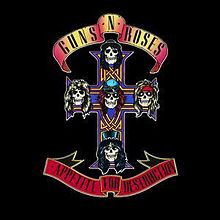
12.
Guns N’ Roses
Appetite For Destruction
[Geffen; 1987]
Appetite for Destruction arose during a time when hair metal was at its peak, and glossy bands like Winger and Poison were dominating MTV. Yet it’s the only album from that era to survive with a strong reputation, mainly because if Motley Crue was the party, Guns N’ Roses provided the hangover: they were dirty, frank and loathed the hedonistic L.A. lifestyle from which they had spawned. They also had immeasurable talent, whether it was the way guitarists Izzy Stradlin and Slash played off each other like the Stones at their height or the raw, irreplaceable voice of singer W. Axl Rose, whose initials spelled “WAR” for a reason. With Appetite, the band collectively took on the pop-metal genre and destroyed it from the inside, creating several smash hit singles in the process; by their next album, the acoustic EP Lies, hair metal was fading, and by 1991, with their heavy and bombastic Illusions records, they had effectively laid the groundwork for the Seattle grunge movement, though Kurt Cobain would perhaps have never admitted it. And to this day it holds up – just try playing the opening riff of “Sweet Child O’ Mine” and not doing the air guitar.
– John Ulmer
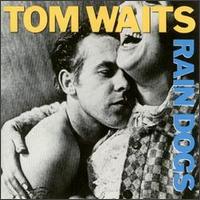
11.
Tom Waits
Rain Dogs
[Island; 1985]
With the assistance of his wife, Kathleen Brennan, and stronger influence from the likes of Captain Beefheart and Howlin’ Wolf, Waits adopted his signature sound in the ‘80s. Rain Dogs epitomizes that effort with his best all-around collection of songs. Inhabiting the New York City underground, Rain Dogs acknowledges the existence of folks many turn their back to: drug dealers, drunks, vagrants, prostitutes and, generally speaking, the destitute denizens of the city. Lyrically, “Gun Street Girl” also reaches out to include transvestite guitarist Falling James. Even Rod Stewart’s cover couldn’t derail the force of “Downtown Train”. Keith Richards checks in to lend guitar to a few tracks and his rusty pipes to back “Blind Love,” while Mark Ribot is responsible for the album’s fiercest hook on “Jockey Full of Bourbon.” Waits assembles a crack squad throughout, complimenting bankrupt ballads and seedy street tales with Chinatown percussion, New Orleans brass and the Southern fiddle. “I’ve seen it all through the yellow windows of the evening train,” Waits asserts, but Rain Dogs is the sound of freighthopping countrywide.
– Michael Tkach

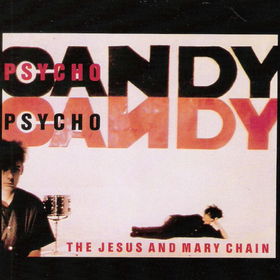
10.
The Jesus and Mary Chain
Psychocandy
[Blanco y Negro 1985]
Never before and never since has a band captured a certain beauty and ugliness like brothers Jim and William Reid did with the release of The Jesus and Mary Chain’s debut album, Psychocandy. Pop melodies collide with what may very well be the most feedback-ridden guitar work ever put to tape. The result is an album that’s like an artist photographing a car accident – the mangled and horrific made beautiful through presentation.
Psychocandy is so chaotic at times it often feels like the songs are moments away from collapsing in on themselves, as if making it to the end of a song is the equivalent of escaping a burning building. This makes the record feel like a moment in time – impossible to replicate or capture once it’s passed. The Reid brothers probably sensed as much – none of the band’s subsequent albums ventured nearly as deep into the sonic territory traversed here. And over twenty-five years later (and counting), no other band has either.
– Cole Zercoe
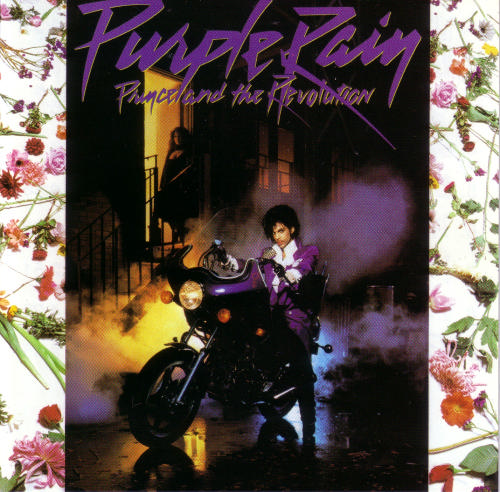
9.
Prince
Purple Rain
[Warner Bros.; 1984]
The notion of a soundtrack being heralded as one of the greatest albums of all time is usually laughable. But, Prince’s Purple Rain was such an incredible album that it eclipsed the film it was originally created for, as the latter now feels like video vignettes for each single instead of a feature film. And whether it be the power-pop style of “Let’s Go Crazy,” the more psychedelic “Darling Nikki,” or the title track’s epic ballad form, Purple Rain was the perfect package of left-field ‘80s experimentation and classic pop bliss. The usual criticism of the album still stands; it’s certainly cheesy at times, but Prince’s impeccable production and dominance behind the mic and on the guitar remain unmatched. And even for its modern popularity, along with going platinum a mere thirteen times, Purple Rain isn’t for everybody. but those with an open mind and the capacity to embrace Prince’s sometimes laughable persona, Purple Rain is one of the finest albums of the ‘80s.
– Erik Burg
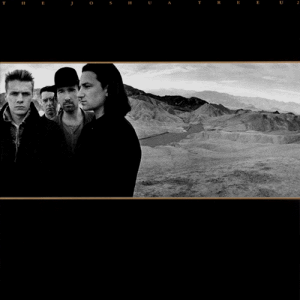
8.
U2
The Joshua Tree
[Island; 1987]
The first side of U2’s fourth album is what made it one of the biggest-selling albums of the ‘80s. Odds are, the first three songs any given person will identify with Bono and company are “Where the Streets Have No Name,” “With or Without You,” and “I Still Haven’t Found What I’m Looking For.” These are great songs, some of the most enduring rock anthems of all time, but what elevates The Joshua Tree beyond your average mid-‘80s smash is how good the deep cuts are. Bono truly comes into his own as a vocalist on “Red Hill Mining Town” and “Exit,” and the Edge’s slide playing on “Running to Stand Still” lends emotional heft to the song’s tale of ravaging heroin addiction. When a band like Coldplay or Snow Patrol is accused of ripping off U2, it’s usually because of this album, which built upon Brian Eno and Daniel Lanois’ advances on The Unforgettable Fire and cemented this sound — delay-drenched guitars and pounding, driving percussion — as “the U2 sound.”
– Sean Highkin
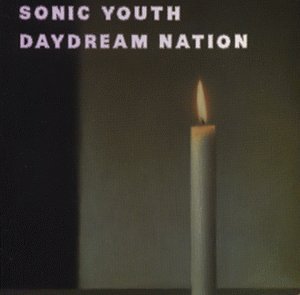
7.
Sonic Youth
Daydream Nation
[Enigma; 1988]
With their previous releases, Sonic Youth had made definite rumblings in the ’80s American underground, but it was with their magnum opus, 1988’s Daydream Nation, that they cracked through and into the consciousness of the wider public. No, it didn’t chart in America, but a band who had previously released songs called “Society is a Hole” and “Death To Our Friends”didn’t really expect to (not to mention what those songs actually sound like). Daydream Nation is not immediate. Over its 70 minute run time you’re taken on a trip through the history of hellish caverns of dank American rock clubs by means of brazen power-punk, detours into dissonance and feedback, through gust-like and trecks across wide expanses of breezy instrumental segments. It’s a lot to take in.
Although Sonic Youth is often thought of as a Thurston Moore-led band, it is Kim Gordon’s brutish vocals that make the most impact here. Daydream Nation is an easy album to appreciate in hindsight, but when it was released it was probably received with a chorus of “what the fuck?”s, and it would have been Gordon’s vocals, spouting killer one liners like “Are you for sale? Fuck you! Does ‘fuck you’ sound simple enough?” or “Look into my eyes, don’t you trust me? You’re so soft you make me hard” that they latched on to initially while the textures and tonalities took their time to fully sink in. Of course there are immediate moments of guitar wizardry that feel visceral from the first listen and with every following listen. These moments probably led to their signing to Geffen and going down a much more direct (and forgettable) route on follow up album Goo – but trying to emulate Daydream Nation would have been just as futile as my trying to encapsulate it in words. Just go listen to it and take a trip.
– Rob Hakimian
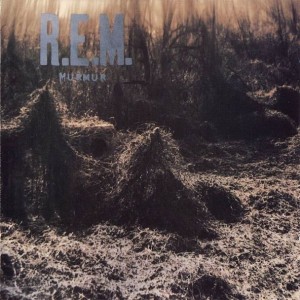
6.
R.E.M.
Murmur
[I.R.S.; 1983]
For American audiences, R.E.M. defined alternative rock during the early eighties. It wasn’t only their sound; R.E.M.’s grassroots business approach of relying on college radio stations forced change on every level of the music industry. Alternative records, once relegated to the back of stores, were now sharing space with Michael Jackson LPs. 1983’s Murmur takes no small part of the credit for that development. What separated Murmur from the rest of the pack was the simple, almost retro production of Mitch Easter. Drums were recorded in a booth, guitars were minimally treated, vocals were almost always cut live, and in stark contrast to contemporary trends, the music was subtle and introspective. This was still a time before frontman Michael Stipe had become comfortable with his celebrity and sexuality, and consequently many of his vocals are mumbled and his lyrics unintelligible. Yet, there are times when an intended meaning peeks through, such as that concerning homelessness and despair on “Talk About The Passion” (“Empty prayer, empty mouths, talk about the passion”). Because of this, the album maintains a feeling of mystery that connects all the songs together. In their subsequent releases, R.E.M. moved away from their jangle-pop sound and began to actually write about things. As such, Murmur remains the most fully-developed album by a band not yet fully developed.
– Jason Hirschhorn
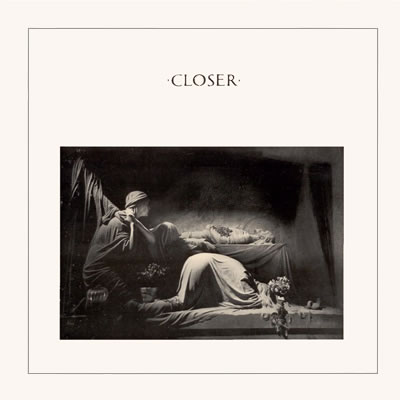
5.
Joy Division
Closer
[Factory; 1980]
The number of releases Joy Division had in relation to their influence is, to put it lightly, disproportionate. They have their second and final statement to thank for that. Closer is a brooding, mesmerizing masterpiece, the perfection of a sound that has inspired countless artists across three decades (not to mention some very successful revival bands). It comes from a very dark place; Ian Curtis took his own life exactly two months before its release. His health and personal issues were well known at the time, and the mind behind the words on this record is clearly an unhealthy one. It’s a little unsettling to think about, but it doesn’t take anything away from the actual product.Closer throbs with frustration, anguish, and twisted majesty, and it still holds up today. Curtis sums it up best on “Twenty Four Hours”: “What once was innocent / Turns on its side”. It may be a swan song, but more than anything else Closer a triumph of mood and atmosphere, venturing far into the dark and doing its best to make sure you can’t find your way back.
– Brendan Frank
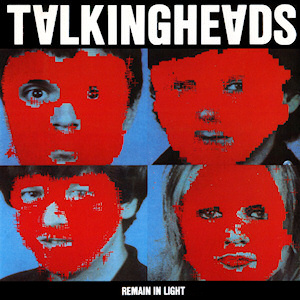
4.
Talking Heads
Remain In Light
[Sire; 1980]
“Born Under Punches” begins Remain In Light with, like, the grooviest shit I’ve ever heard. David Byrne’s disembodied howl, like the manic side of you that only emerges under very specific circumstances, is concise, literate and fourth-wall destroying. Eno’s watchmaker handling of the band’s rhythms and counter-rhythms, bleepy boop samples and belly-exploding funk is unrivaled. The record’s frantic pacing and schizophrenic instrument gestures, as well as the cultural, historical and mythological makeup of Byrne’s lyrical panorama together enact paranoia on a personal and collective level.
When the lead guitar shows up on “The Great Curve,” practically tearing the song away from itself, I feel like this is the album Pink Floyd wanted to make, and Talking Heads did it with like half the minutes (it’s a spastic but painfully brief 38 minute ride beginning to end). Probably the album’s most famous track, the horrifying “Once In a Lifetime” juxtaposes a very-real terror of arriving at adulthood with one of the highest-flying choruses in rock and roll. Released in late 1980, Remain In Light, in all its neon-cocaine immortality, sounded in the decade and dominated it.
– FM Stringer

3.
Michael Jackson
Thriller
[Epic; 1982]
Being such a mainstream success and an inherent part of the American pop music landscape, it’s easy to forget that Thriller is also an incredibly weird album. Turning away from the happy-go-lucky let-the-good-times-roll vibes of his discofied classic Off the Wall, on Thriller Jackson began to explore the celebrity paranoia that would come to dominate his work (and, arguably, his life). Opener “Wanna Be Starting Something” finds Jackson warning an unnamed “you” (presumably, a more naïve version of himself) that more than a few industry insiders will look to take advantage of his talents: “still they hate you, you’re a vegetable, you’re a buffet, they eat off of you,” while unnamed voices scream and yelp in the background. Speaking of “taking advantage,” let’s take a moment to consider “Billie Jean,” the standout track on an album packed with highlights. The song has since become a dancefloor classic, but in essence it’s a scary track; echoing strings rescued from some crumbling discotheque punctuate an eerie, almost ominous beat and chugging bassline while Jackson sings about a girl attempting to extort child support money (and perhaps attention) from the star himself, despite the fact that “the kid is not my son.” And on “Beat It,” which features perhaps the hardest-rocking guitar work to ever be successfully employed by an R&B track, Jackson says “they’re out to get you, better leave while you can.” Despite these warnings about the trappings of fame, however, the spotlight proved irresistible — maybe as necessary as oxygen — to MJ, and his struggle to come to grips with the glory/shame paradox of the entertainment industry would only grew more difficult in later years. But fortunately for us, before all that — before the trials and the surgeries and the defensiveness and the Martin Bashir documentaries — before his life spun out of control, Jackson and producer Quincy Jones recorded nine pitch-perfect synth-pop songs about fear and love. The fears Jackson expressed on Thriller would eventually consume him, but back in 1982, Jackson still had the presence of mind to combine self-awareness, giddy anticipation (i.e. “P.Y.T. (Pretty Young Thing)” and the ridiculous track-ending machismo-infused dialogue between MJ and Paul McCartney on “The Girl is Mine”), and a creeping realization that fame’s never easy. Thriller might, in retrospect, represent Michael Jackson’s demons, but it’s also his artistic calling card: bizarre, unforgettable, and the result of both hard work and enormous musical talent. The same could be said of Jackson’s career as a whole, and perhaps that’s the point.
– Josh Becker

2.
Pixies
Doolittle
[4AD; 1989]
It’s hard to believe that the Pixies’ first two full-length albums, Surfer Rosa and Doolittle, came out a little more than a year apart in the late-’80s. Working with a new producer in Gil Norton, 40K in recording budget brought in by a fat deal with Elektra Records, and a fair amount of attention following the relative underground success of Surfer Rosa, Doolittle was a success in every measurable way, charting highly in the UK and earning a pair of modern rock radio hits. Still, historical context doesn’t begin to explain how fresh the album still sounds more than 20 years after its release. “Debaser” burns with enough intensity to raise the dead as Black Francis recalls an surrealist film experience, the “uh huh uh” duet between Black and Kim Deal on “Tame” is the definition of tension, and “Here Comes Your Man” shows that the Pixies were a ‘60s pop group in another life. And, of course, there is “Hey,” among the sexiest songs ever written. Their loud-quiet-loud formula would be the foundation on which Nirvana would build their sound, and countless others to follow, but Pixies never made like they were doing anything innovative while they were around. They were, through and through, a college band from Massachusetts who disappeared before any backlash could ever form, with Doolittle serving as their crowing achievement.
– Philip Cosores
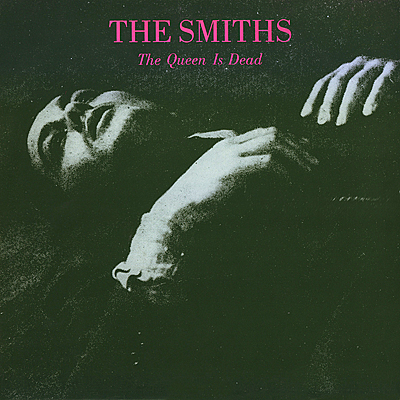
1.
The Smiths
The Queen Is Dead
[Rough Trade; 1986]
On the surface, it would seem unlikely that this would be the quintessential rock album of the 1980s, but it actually isn’t that weird. The audience for early alternative and “college” rock was, in a lot of cases, teens and young adults who were socially awkward, especially around girls. And while this has been one of the most commonly utilized subjects throughout the history of pop music, arguably nobody has portrayed it with more effectiveness and crushing accuracy than one Steven Patrick Morrissey. The Queen is Dead is Morrissey’s peak as a lyricist, including “Bigmouth Strikes Again,” “I Know It’s Over,” and especially “There is a Light That Never Goes Out.”
The Queen is Dead is also Johnny Marr’s high-water mark as a guitarist. Along with R.E.M., Marr’s style more or less laid the groundwork for indie mainstays today from the Shins to the Decemberists. The Smiths’ first two albums suffered either from an overabundance of filler tracks or a lack of cohesion in their sound. On The Queen is Dead, everything coalesced. There isn’t an ounce of fat in its 35 minutes, and even the tracks that aren’t towering classics (“Vicar in a Tutu,” “Some Girls are Bigger Than Others”) are fantastic. Morrissey would have some high points in his solo career, but neither he nor Marr would ever come close to topping this. However, when so few other people have, it’s hard to hold that against them.
– Sean Highkin
